Drømmen om Galapagos
Stein Hoff


Part IV
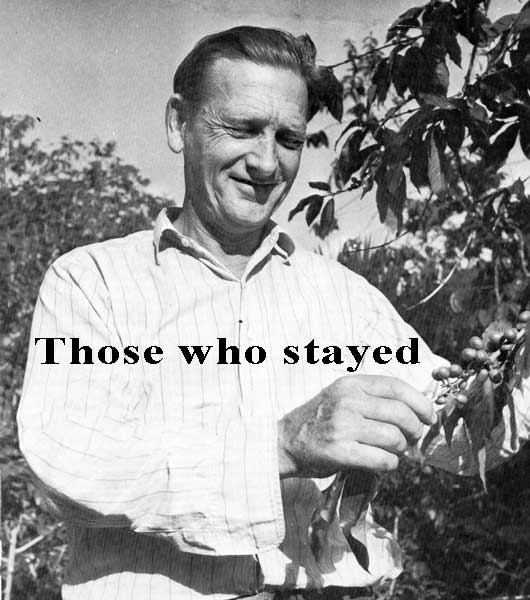
For many years Gordon Wold was Galápagos' third largest supplier of coffee, and was honored with the title “King of Coffee.” Photo courtesy of Miriam Brekke, Porsgrunn.
“…about 75% happy with life”
Gordon Wold from Porsgrunn, and Kristian Edvardsen from Stampa farm in Hedrum directly north of Larvik, were the only ones of the Ulva expedition who never wavered in their belief that Santa Cruz offered a good living.
Kristian soon changed his surname to Stampa. In Spanish there are problems in pronouncing “s” at the beginning of a word, so he was usually called “Estampa,” not inappropriate as he thereby retained the “E” for Edvardsen, his middle name.
For several years Stampa and Wold kept together through thick and thin, and depended on each other in their fight for survival. On the beach, each lived in one of the small houses located behind the factory, but “arriba” (in the highlands) they took joint possession of a house at Fortuna. It was the house that was first built for Anders Rambech and Sigvart Tuset, who at that time were responsible for farming on the island, and the same house that “Pig Johansen” inhabited prior to his departure.
During the most sparsely populated period in 1929-30 there were rarely more than three people on the island: the two Norwegians and the Ecuadorian Elias Sanchez. Sanchez was the only one of the original workers who lived on the island when Ulva arrived in August 1926. He told them that he had been on Santa Cruz since 1917, but said nothing about his past. Probably he was one of the political prisoners who was deported to the islands to be used as free labor.
When the human population on Santa Cruz slowly but surely began to increase, it was because of an influx of north-European settlers. They came, as did many before them, driven by an urge for adventure and the hope of finding both a Pacific paradise and a place where they could earn a living. The stark realities made only a few stay longer than a couple of months.
One who held out for a long time was the Danish-American engineer, R. H. [Rudolph Hother] Ræder. He possessed what, regrettably, is most important for success whether in Galápagos or other places in the world, a good supply of cash. Consequently there was also work for others, as Ræder wanted a nice house at the beach for himself and his wife. He had several small huts built for his workmen, as well as a large storehouse in which, among other things, bacalao could be protected from flies and rain. After futile attempts to get the canning factory operational, Ræder also switched to bacalao production, especially before Lent. For this purpose he needed a crew to fish for him.
In addition to fishing, the illegal sale of living tortoises was the colonist's surest source of income. Almost without exception the clients were sailors aboard ships and yachts. Even then tortoises were a protected species and therefore could not legally be sent to Guayaquil. On the local black market in Galápagos there was a good price for the oil rendered from tortoise fat.
One of the men who worked for Ræder was the Norwegian, Ewald Formo, who first came to Galápagos aboard Albemarle but early on moved to Guayaquil.
When Paul Bruun died in the Isabela accident, it was Arthur Worm-Müller's turn to move from Casa Matriz on Floreana into the empty factory in Academy Bay. He also tempted his wife, Hilda, to try out living for a time on the island. The governor appointed Worm-Müller to the unpaid position of the island's comisario—a kind of deputy representative.
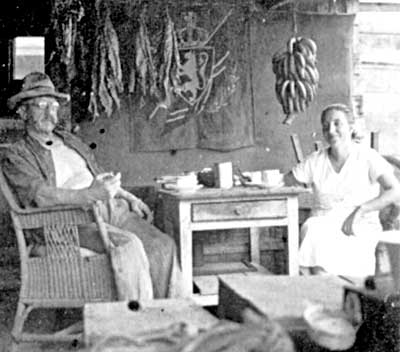
Arthur and Hilda Worm-Müller, Santa Cruz, 1936. Photo courtesy of Rolf Blomberg, Quito.
In the Fall of 1931, about the same time that Worm-Müller settles on his third Galápagos island (he had previously resided on San Cristóbal as well as Floreana), the relationship between Stampa and Wold comes to an end. They have stayed together nearly day and night for five years and are now tired of each other.
The two agree to share equally their common property, and they do it literally. The cultivated land on Fortuna is partitioned with fences into two parcels of exactly the same size, and the house is sawed in half down the middle. Stampa transports his portion down to the beach. For many years, Wold's house at Fortuna had only mosquito netting on the exposed side.
Luckily, Stampa's 24-ft Falcon was spared from subdivision!
A factor contributing to the old friends going separate ways was the population increase on the island, thereby lessening their dependence on each other. Trygve Nuggerud (it is still more than a year until the Baroness arrives in Floreana) moves from San Cristóbal and settles on Santa Cruz with his wife María and boat Dinamita. Now there are three fishing groups on the island: Stampa's, Ræder's and Nuggerud's. Each group employs between 2 and 6 local Ecuadorian fishermen.
In addition, the 54 year old Captain Herman H. Lundh arrives from Oslo to explore the prospects on Santa Cruz. He and Wold, who now concentrate on cultivating coffee, become good friends. They consider purchasing a larger boat for use in fishing and transport between the islands and the continent.
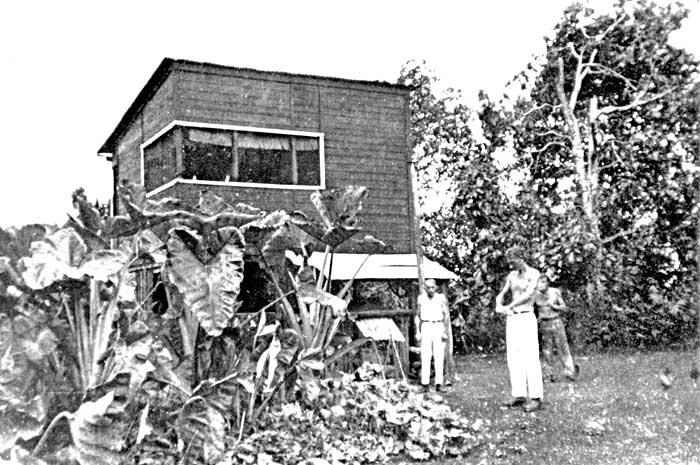
When Wold and Stampa separated, their house at Fortuna (later renamed Bellavista) was divided down the middle. Wold was a hard worker, but he had no enthusiasm for house maintenance. Captain Herman Lundh also considered the house good enough when he moved in and lived there from 1938 to his death in 1947. Lundh, to the left, Wold to the right. The large leaves belong to the important tuberous plant otoya. Photo courtesy of Jacob Lundh, Oslo.
Worm-Müller is a faithful correspondent. A letter to his brother Jacob in the Spring of 1932 gives a contemporary impression of life in Santa Cruz:
“A while ago we sailed to Floreana to pick up my roofing sheets. As cash is scarce, I paid Stampa with 20 of the sheets. I sold some to the Dane and kept 20 for myself. The crossing to Floreana was beautiful. We sailed all the way. It took 7½ hours, which is a record time. Stampa removed the sheets and I carried them down to the beach. Believe me, it is quite a sight now, with lots of removable items missing, as is to be expected. Stampa made a trip to the highlands and killed an ox. It required two trips to bring the carcass to the beach. I cut it up for drying and salting. We stayed there for four days but should have remained at least one day longer because part of the meat that we hung up to dry did not hang long enough. Half of it has become spoiled by maggots. The salted portion was fine and we still have some left.
“One day we went tortuga (sea turtle) hunting in the big bay where they are plentiful. Stampa, Formo, a Norwegian who works for the Dane, and I. It took 1½ hours to go there by motorboat. We were rather late for catching. Well, we entered, anchored the boat and jumped into the dinghy. One man at each end of the dinghy and I at the oars. The trick is to arrive directly over a tortuga as it lays on the bottom, but the water must not be deeper than a man can stand in. When we find such a place, one man jumps head first into the water, trying to grab the turtle by the neck or one of the flippers. Provided he gets a good hold, the other man jumps out to assist and ties a rope around the turtle. With that accomplished the turtle is towed to the larger boat and hauled aboard; then we go for more.
It is great fun watching, and the boys really enjoy the sport. Water sprays all around the three of us, and one sees nothing but a big wrestling lump.
“We got three turtles, large beasts, and had to leave because the tide was very low. We got out alright without having touched bottom more than once, and then only lightly. The surf was big, the bow of the boat was rising up and crashing down; I was glad it was not my boat.
“The following day we boiled the fat which yielded 25 litres (6.5 gals.), enough for some weeks to come. The stench was hellish.
“Initially I couldn't eat food that was fried in it, but now I can because we have nothing else. However, the fat of the tortoise (land turtle) tastes something like olive oil and is really excellent.
“Here there is a scarcity of matches, which is annoying. I can only smoke when the sun is shining, I have to use a magnifying glass…
“…I have 45 sucres to buy merchandise in town. Get what I need for this amount. I had a wild hope of buying a pound of butter, but that amount of cash is insufficient. Butter is considered the greatest of luxuries, you understand, that is why I have such a craving for it.
“Tobacco cannot be cultivated down here as an insect devours all the leaves.
“We were recently on a trip to San Cristóbal. The Dane paid for the fuel as Stampa had no more. The cruise took 11 hours by motorboat. There was mail there for some but none for me. I bought 20 eggs. Believe me, they were delicious, another luxury. They cost 10 centavos (1 sucre=100 centavos) each. I feel I get most out of them when prepared as eggnog. Incidentally, not much happens here, it's a life mostly in peace and quiet. I'm about 75% happy with life, and who could ask for more in these hard times?…”
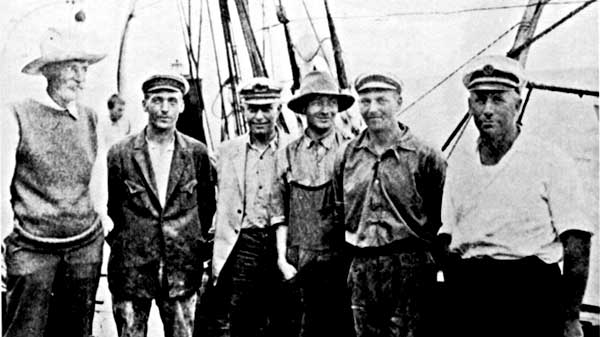
When provisions from Guayaquil were typically delayed or non-existent, visiting ships and sailors gave valuable assistance to the Norwegians. Here aboard the Mary Pinchot in 1929 are, at left, Governor of Pennsylvania Gifford Pinchot and Kristian Stampa. Fourth and fifth from the left are Trygve Nuggerud and Erling Jenssen from Trondheim. Photo from Pinchot's book To the South Seas.
In 1932, Anna and Jacob Horneman also return to “Villa Villnis” (“Wilderness House”) after an absence of three years. The name of the house is now very appropriate. It is so overgrown that they have difficulty in finding it.
Meanwhile, their youngest son, Christian, who was born in Norway, stays behind with Anna's parents in Lillesand, but four year old Robert accompanies them. In August of the same year, Robert gets a playmate when Herman Lundh's wife, Helga, and their son Jacob, arrive from Oslo. Jacob is also four years old.
Herman Lundh and Gordon Wold have now joined in a business venture and purchased the sloop Santa Inez. By so doing they revive Olav Eilertsen's old dream of a freighter to the continent, owned and managed by Norwegians. Up to now the islanders' biggest problem has been the unreliable export facilities for bacalao and the irregular supply service from outside. The old Manuel J. Cobos has been taken over by the local government and rechristened San Cristóbal. This has actually improved connections with the continent as far as mail and passenger traffic is concerned, but in return the price for freighting has increased threefold—to the great despair of the bacalao fishermen.
The one-masted Santa Inez is able to carry a load of 60 tons, needs only a crew of two and should be ideal for the colonists' needs.
With the number of inhabitants on the island into two digits, including women and children, a new engine in his Falcon, and improved facilities both for people and bacalao, Stampa considers that it is time to invite his fiancée, Alvhild Holand, to Santa Cruz.
The original plan was that she should join her Kristian as soon as Ulva colonists had made a decent start. But with all the problems arising, he felt that Santa Cruz was no place to raise a family. Not until now— seven years later.
He writes to Alvhild, who lives in Kodal near Sandefjord. She arranges passage aboard the Haugesund-registered ship Marie Bakke, and arrives in Guayaquil in April 1933. The man who greets her in Guayaquil is quite different from the 25-year-old who left Norway in 1926. Kristian Stampa is now tanned like a native, tall, slender and wiry. He has matured in those seven years and is marked by the struggle for survival—a process that has inflicted both sickness and privations. The lean man is emaciated as a result of recent attacks of dysentery. Once in 1929 he was so sick that Bruun took him aboard “Cobos” to Guayaquil to get him to a physician. Together with Wold he also has had his share of shipwrecks, but has survived, thanks to his craftiness and toughness.
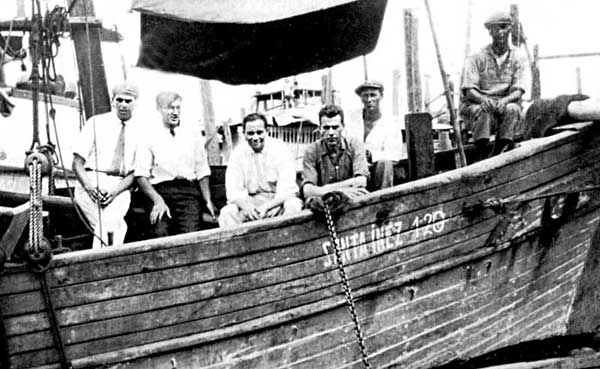
Alvild and Kristian marry in Guayaquil—first in English by an American clergyman and afterwards in Spanish by a local judge. Ecuadorian law requires a civilian marriage ceremony. Alvhild is not versed in any of these languages, but she trusts her Kristian.
The sloop Santa Inez was to fulfull the old dream about a freighter run by Norwegians. Instead, it was mostly hard work, expenses and repairs. After two years Lundh and Wold gave up. The photo was taken in Guayaquil in 1934 when Jens Moe (seated behind the anchor chain) returned to Galápagos. To his left is the Swedish author Rolf Blomberg and Wold is seated behind and to the right of Moe. Photo courtesy of Jacob Lundh, Oslo.
Alvhild Stampa becomes a housewife on Santa Cruz—and really thrives. Her ability to cope with and adapt to her environment is no less than Kristian's. She soon knows all the unfamiliar vegetables, she fries platanas in tortoise oil and bakes sourdough bread in her wooden stove. When she becomes pregnant, she wants to give birth on Santa Cruz. The nearest midwife is on San Cristóbal, the nearest physician in Guayaquil on the continent. Kristian fetches the midwife, and on April 12, 1934, Anne Carmen Dolores Stampa is successfully delivered. As a result, she is the first baby of European colonists born on the island. [As far as we know, this was the first birth ever on Santa Cruz. Others had gone to San Cristóbal.]
With a little one in the house, milk is needed. Hence, Kristian sails to the island of Santiago where there are herds of feral goats. He catches several females with kids and brings them back to Academy Bay.
After receiving water, corn, and bananas, the animals soon become so tame that they return home each morning to get water and be milked. Stampa also makes a fitting cradle for Anne—the carapace (upper half of the shell) of a full-grown Galápagos tortoise!
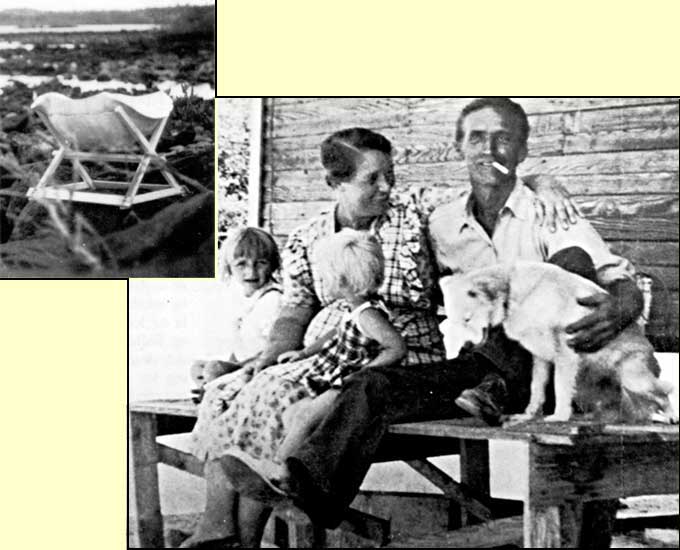
Happy days on Santa Cruz. From left, “Friedelpeter” Horneman, Alvhild with Marit on her lap, and Kristian Stampa with their dog “Topsy”photographed at “Arena Blanca” in 1944. Inset shows the cradle which Kristian Stampa made out of a tortoise shell in 1934. It lay well hidden and forgotten in a shed next to “Arena Blanca” until May, 1985. Photos courtesy of Jacob Lundh and Andrew Fraser (inset).
The New Commissioner
For a while now the Galápagos gods have been kind. But after this sunny interim, drought and misery sets in with the most dramatic year in the islands' history. The Baroness and Philippson disappear; Lorenz, Nuggerud, Pasmino and Ritter die.
A German family settles on Santa Cruz; Karl and Marga Kubler and their daughter Carmen. Before he travels to the island, Karl Kubler takes out Ecuadorian citizenship and visits various authorities. When he arrives on Santa Cruz, he announces that he has been appointed as new comisario (commissioner) and will live in the factory building. The governor is said to have declared that the building as well as the houses of Stampa and Wold as public property!
Wold, who lives at Fortuna when he is not aboard Santa Inez, loses his house to an Ecuadorian soldier in the company of Kubler. The Stampa family continues to resist expulsion from their house, but Worm-Müller is thrown out of the factory and sees no alternative but to move into the old chicken house behind the factory. At the same time they lose access to the factory's cistern with its accumulated rainwater.
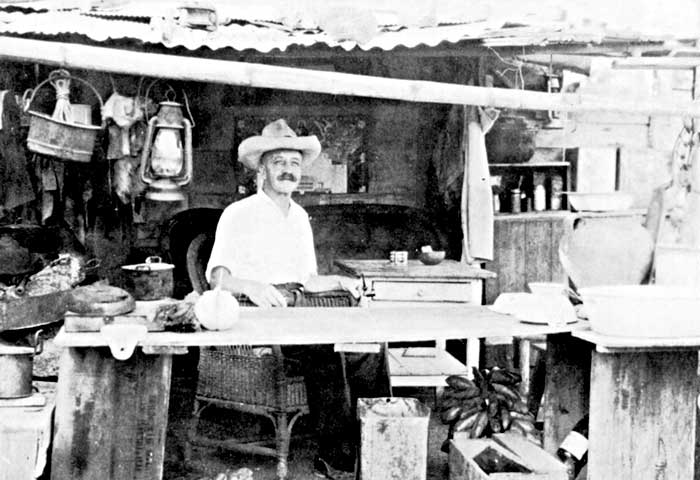
Arthur Worm-Müller had to get out of the factory when Karl Kubler§ arrived with his family in 1934. But gradually he thrived in his refurbished chicken house. He had no children but is remembered by the youngsters of the 1930's as a pleasant uncle-figure. Photo courtesy of Jacob Worm-Müller, Oslo.
§ In her unpublished What Happened On Galápagos?, Margret Wittmer states that Kubler lived on Isabela for a while, then sent for his wife and daughter to join him. Apparently he moved to Santa Cruz after they arrived from Spain. In Leon Mandel—Field Museum Galapagos Expedtion, Mandel's wife Carola describes Kubler and his house.
After much work, the Worm-Müllers have it quite cosy in their restored chicken house, but soon Hilda considers it too primitive and returns to Guayaquil.
Another status report from Worm-Müller, dated December 1, 1934:
“We have had quite a few changes here. The German who arrived here and had me put out of the factory building became so unreasonable that we got the governor to dismiss him as “comisario.” Now he has toned down a good deal but still tries give us Norwegians and the Dane as much trouble as possible. He was overheard agitating the natives to kill us, so we sent for Stampa and Wold who were up in the hills harvesting their coffee. The plan was to “take” each of us, one at a time, and the fellows up in the hills were to be “taken” first. Naturally, we said nothing but walked around with our firearms plainly visible.
“When one man had to attend his boat, for example, another stood on the landing pier with a rifle. These were not the nicest days I have had on the island. Imagine nights with a gun at the bedside! Now all that is passed and everything continues as before.”
The next mishap to befall the colony comes when Santa Inez runs aground near Esmeraldas, on the north coast of Ecuador. During the two years that the boat was used for fishing and freighting it caused many problems for the Norwegians because of engine failure, incessant repairs and endless expenses. Finally, Wold is exasperated and after the last disaster declares that the ship is bewitched. But nobody perishes and Wold considers himself lucky to have had a another narrow escape. He decides in earnest to concentrate only on his coffee plants. Besides he recently got a nice neighbor. Jens Moe, who originally was aboard “Ulva,” has returned from Colombia and settled in the hills arriba between Wold and Horneman, where he is busy establishing a chicken and pineapple farm.
Herman and Helga Lundh give up for the time being after the fiasco with Santa Inez. They move to Guayaquil.
The Stampa family becomes a friend of William A. Robinson, an American sailor who is visiting the Galápagos in 1934. A few years earlier he sailed around the world in his 32 ft. ketch Svaap. After that accomplishment and the book he subsequently wrote, he has became world famous. Now he is back again at one of his favorite places to produce a nature film. Moreover, he is fascinated by the Norwegian colonists and wants to write a book about them.
Stampa helps with the preparations for filming, and Worm-Müller provides information about the Norwegian expeditions.
Robinson has a base camp in Tagus Cove on Isabela and is getting on well with his filming when he develops a ruptured appendix and peritonitis (abdominal inflamation). A coincidental visit of a ship with a wireless radio aboard saves him. His condition is reported to the Canal Zone where a military sea plane departs for Tagus Cove and flies him to the mainland. [This was history's first airplane service to the Galápagos.] While in the hospital in Balboa, thieves vandalize his yacht and strip it of everything of value. Only the engine is recovered by an American fishing boat, which reports the damages by radio.
Robinson cannot bear returning to his beloved boat in the Galápagos and decides instead to give the hull to Stampa and Worm-Müller in appreciation of all their assistance.
Just after New Year, 1935, Stampa sails Falcon the long way around to Tagus Cove and tows the hull of Svaap back to Academy Bay. The newly installed governor, Colonel Carlos Puenta at San Cristóbal, does not appear any friendlier to the Norwegians than his predecessor. He does not accept the explanation that the hull is a personal gift, since there are no documents to this effect, only a radio communication to Stampa through the fishing boat. Promptly the governor confiscates the yacht and tows it on to Wreck Bay. Robinson has arrived at Tahiti before he receives news of what has happened. While the dispute over ownership continues by telegraph and letter, Svaap is one night driven ashore in Wreck Bay and damaged. It is now February 1936!
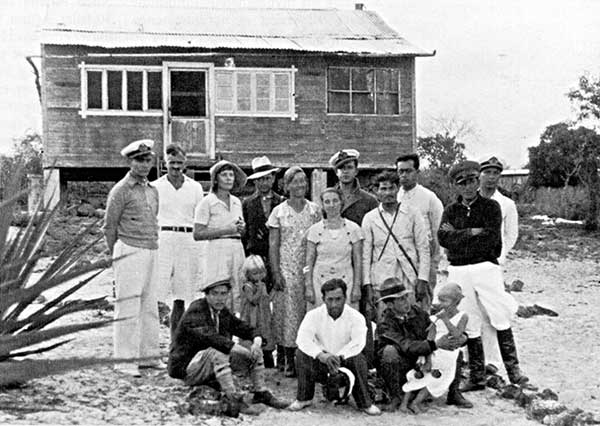
A group of scientists from the University of Quito visiting in 1938, here photographed in front of the Stampa family's first house. Standing, second from left is Karl Kubler, then Helga Lundh and in front of her, Anne Stampa who holds the hand of her mother, Alvhild. Next to her is Solveig Graffer. Photo courtesy of Jacob Lundh, Oslo.
Reluctantly, the authorities finally agree that the wreck does belong to the Norwegians. Stampa and Worm-Müller sell it for 30 dollars.
Svaap is sanskrit for dream. Does this spell the end of a dream of that new and modern motorsailer for the Stampa family? Oh no! Puffing his pipe, Stampa studies Falcon from all angles. Is it possible to rebuild an open Norwegian motorboat into a proper auxiliary yacht? [Meaning a sailboat with engine.]
In the Fall of 1936, Falcon is pulled ashore. The boat is 24 ft. long, has one mast and is only half decked. Stampa has his past experience in cutting constructions down the middle, and that is what he does with the boat. He separates the halves by a space of two meters (6.5 ft.), adds boards and beams, a deeper keel, lays a complete deck, splices the wires, sews the sails, erects one more mast. After some months he launches a white-painted 30 ft. ketch—an ocean-going yacht almost in the same class as Svaap.
Towards the end of the thirties, new colonists continue to arrive in Santa Cruz. One more Ulva-man returns in 1935; it is Anders Rambech. The next year his fiancé arrives, Solveig Hansen from Oslo. The Kastdalen and Graffer families from Rjukan also arrive in 1935 with a huge cargo. Later, the Lundberg family from Sweden and several German and Ecuadorian families follow.
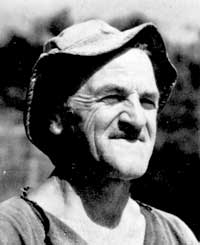
Anders Rambech was the last of the four original Ulva members who decided that Santa Cruz really was a paradise. He returned in 1935. Photo courtesy of Per Høst, 1953.
In 1938, Herman and Helga Lundh are back after four years on the continent. They have Jacob with them—who is now 10 years old—and the four year old Eric. In the same year, Jacob Horneman is in Europe and returns with a new wife, Elfriede Engelmann from Frankfurt, Germany. Anna had her fill of Galápagos and in 1933 finally moved to Lillesand with Robert. By the late thirties, others also leave the island. In 1937, Arthur Wurm-Müller becomes ill and moves back to Guayaquil to join his wife Hilda. She has made brief visits to Norway and the U.S.A. where she has studied hairdresssing and cosmetology and has opened a parlor that is ultimately successful. Ræder understands that there is little money to be earned in the Galápagos and he, together with his wife, also leaves. María Nuggerud sells her small property to Kubler and moves with little Oscar Trygve to the continent. She does not speak Norwegian and most Norwegians among the Europeans do not speak Spanish. There is also a definite class distinction which prevents communication and association. A “Señorita” from an ordinary Ecuadorian working class family might be acceptable as a mistress but as yet not as a wife.
The Canning Factory Burns
In 1938 there are so many people on Santa Cruz that an army garrison is established on the island. For this the factory and the two oldest houses are needed. Now it is Kubler's turn to move out. The Stampa family has to be content with one of the cabins used by Ræder's workmen.
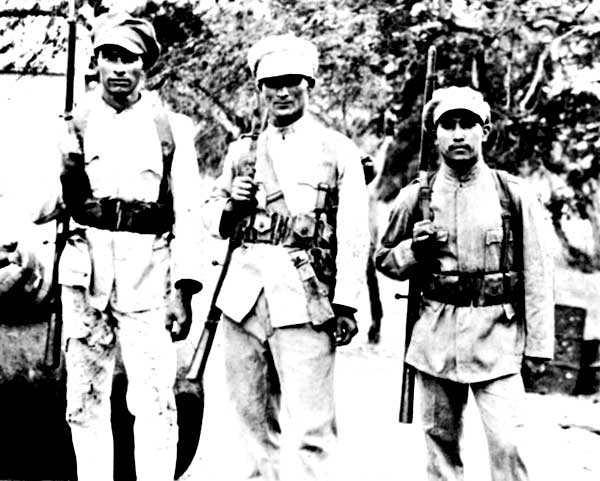
Three Ecuadorian soldiers at Wreck Bay in 1933. Photo courtesy of John S. Garth, Los Angeles.
The chief of the garrison is Lieutenant Gonzalo V. Bedoya. On his staff are a half dozen soldiers and a few servants. One evening, while the men are playing cards upstairs in the factory, a servant adds more kerosene to one of the lamps without first extinguishing the flame. The container is filled to overflowing with the kerosene dripping over the floor. The very dry Norwegian wood catches fire immediately and within seconds the flames are licking up the walls. Everyone escapes unhurt except for the boy who started the fire; he receives some minor burns. But the entire building is soon ablaze; and the army's store of ammunition and dynamite is also ignited. And so the twelve year old factory is totally consumed by fire to the accompaniment of a barrage of shots and heavy explosions. None of the other houses catch fire. In retrospect, one can say that the factory went down with a final salute that was a fitting tribute to the Norwegian pioneers!
Next morning there is a knocking on the door of the Ræder house where the Lundh family is staying. Ten-year old Jacob will never forget the sight that meets him when he opens the door. There Lieutenant Bedoya is standing, dressed only in his underwear but wearing his officer's cap, and very embarassingly asking for help with food and clothing for himself and his men.
The poor soldiers got help from Lundh, Stampa and the others, and following this there comes a change for the better in the relationship between the authorities and the “foreign natives.” So although it was sad to lose the fine building, it brought about something good.
When the Stampa family had to move, they decided to build a house near Bahia Salinas, the Salt Bay. Up to now no one had been building beyond Punta Estrada, the southern headland of Academy Bay. In the past this was where seawater was trapped with small dikes during spring tide. When the water evaporated the salt could be harvested. The small inlet provided a good harbor for Falcon, and it was also a beautiful bay, bordered by dense green mangroves silhouetted against white coral sand and black lava headlands, with azure surf beyond.
There was a perpetual lack of cash and raw materials, but Stampa knew, after working on Falcon, that the local heavy hardwood, matazarno [Erythrina velutina] was an excellent material. With the help of tools from Kastdalen and Graffer, he felled trees arriba and sawed them into rafters and boards. Slowly but surely there arose a beautiful house with concrete cisterns, balcony and a stone wall along the beach. It was an isolated site, so they needed a rowboat to get from Punta Estrada to the other side of Academy Bay. But the rewards were peace and quiet and the most beautiful view of the playa.
The house was named “Arena Blanca,” White Sand.
Between World Wars I and II, income was sparse. Tons of bacalao were harvested, salted and dried—and often wasted. The company in charge of “San Cristóbal,” which set the freight rates, was rarely willing to cooperate with the Norwegian fishermen. This was understandable as the company had their own fishermen at Wreck Bay. The situation reflected Ecuador's poor economy, with everyone struggling to make a living. The United States was interested in purchasing the archipelago by virtue of its strategic position with respect to the Panama Canal. This is one of the reasons why President Roosevelt personally visited the islands in 1938. But strangely enough, none of Ecuador's ever changing governments showed any interest in this proposition. In 1934 the islands were already declared a National Park—a most commendable action by a near penniless nation!
Had it not been for foreign ships which often called, and American adventurers and scientists leaving behind both currency and equipment, the colony on Santa Cruz could hardly have survived. The Europeans had great problems accepting the living standards of poor Ecuadorian workers. So far they had neither school nor doctor on the island and a lot of compromises had to made.
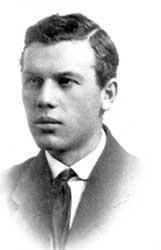
Jens Moe, 1926. Photo courtesy of Gudron Moe, Kragerø.
Jens Moe was the first to acquire a radio, and it was he who first heard that Germany had invaded Norway in 1940, scarcely without resistance. Alvhild Stampa remembers how all the Norwegians gathered in Kastdalen's house afterwards. The house was called “Miramar” (“Ocean View”) and was located near Horneman's. They had a hand-cranked gramophone, and when somebody played the nostalgic hit,“Beneath the Old Lilac,” there were several who wept.
They did not yet know that the war, paradoxically, would become a goldmine for the colony. In 1941 the United States signed a leasing agreement with Ecuador and established a large military base on the island of Baltra, situated directly north of Santa Cruz. Within record time, the population of Galápagos increased spectacularly, and now they had an airstrip, a radio station, shops, physicians and hospital. And customers!
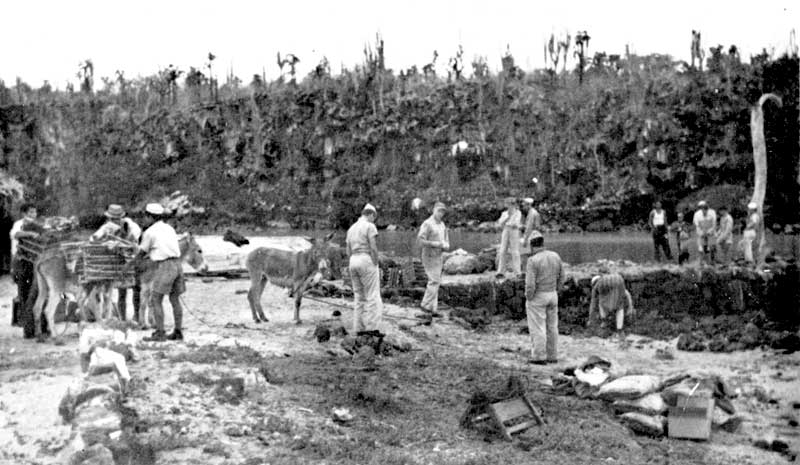
With World War II and the American base at Baltra, prosperity comes to Galápagos. Soldiers picked up provisions at the Ulva pier or they were delivered by motorboats to Baltra. Photo courtest of the Kastdalen family, Santa Cruz.
To help supply the seven thousand servicemen stationed on Baltra, the Americans purchased all that could be fished, caught and produced. And at a good price. They arrived in boats according to a schedule, or one could deliver a catch of fresh fish oneself. Not uncommonly, the orders arrived by airmail, literally.
Kristian Stampa received from the Americans detailed ocean maps of the region, which enabled him to explore reefs and shallows that prove to be fine fishing grounds previously unknown to him. The fishing became better than ever and the income sky high. Alvhild could afford a trip to Guayaquil bringing back leather-upholstered furniture and other “luxury items.” And, not the least important, they could afford to bring more children into the world. In 1942 Marit arrived, and in 1945, Knut. Both were born on Arena Blanca and both were cradled in the same tortoise shell their father had made when Anne was born.
In 1947, the United States paid the last of her leasing loan to Ecuador, donated the wooden barracks to Galápagos residents and bulldozed the remains of the base into the ocean. Ecuador took over the airfield and soon started regular air traffic to Guayaquil. Modern civilization was about to embrace Galápagos.
By 1948, it was time for the Stampa family to have a well-earned vacation. Kristian had not been home in Norway for 22 years, and for Alvhild it was 15 years. Their good financial status allowed them to take along all three children. They planned to have Anne stay with her aunt in Stokke near Sandefjord and attend Rørkoll school.
The rest of the family would return with a new Norwegian Galápagos expedition…
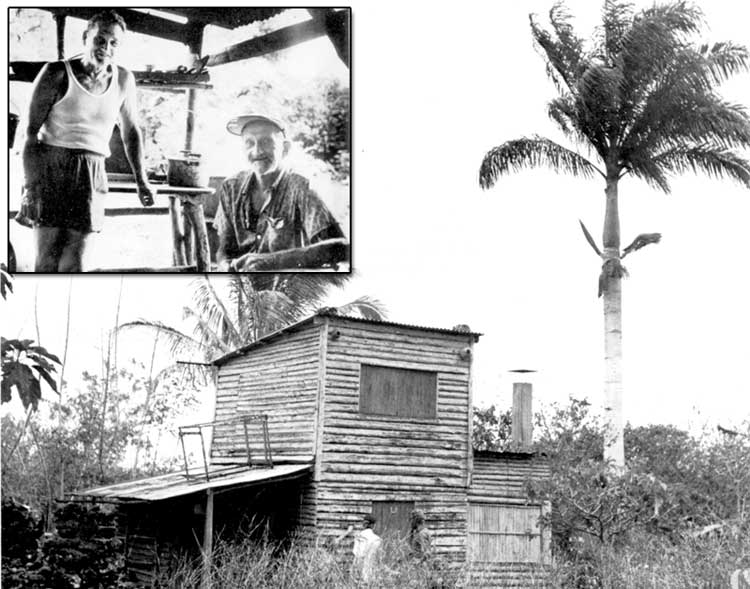
Just as a cobbler's children are often without shoes, so the house of carpenter and master builder Sigurd Graffer was not a luxury dwelling. In 1958 his family had left him and he lived mostly down at the beach. The house in the highlands was overgrown, and the timber rotting. Photo Courtesy of Erling Brunborg, Oslo.
Inset: Many an enjoyable mug of coffee was served between the supporting poles of Wold's house. Here are Gordon Wold and Sigurd Graffer, about 1965. Photo courtesy of Sven Gillsäter, Sweden.
The Thalassa Tragedy
The Stampa family traveled from Guayaquil aboard Sophie Bakke of Haugesund and were home in Norway on Midsummer Day, 1948. [St. John's Day, June 23rd.] Anne 14, Marit 5, and Knut 3 years old suddenly became acquainted with numerous grandparents, uncles, aunts and cousins. All wanted to please the travelers from the exotic islands in the Pacific, show them the home country and entertain them.
The children, especially Anne, got tired of all the fuss in the beginning. She wished she were far away when journalists arrived, took photographs, and asked all sorts of silly questions.
For Alvhild and Kristian the visit was important for another reason besides meeting the family again. It was a small triumph, a demonstration of success. Previously, it was concluded in Norway that Galápagos expeditions were financial fiascos and that life on the islands mainly consists of dangerous toil with small gain. And here were Kristian and his family, returning with a bulging purse and a photo album filled with evidence of an exciting life among cacti and tortoises, iguanas, a baroness, presidents and millionaires! Apart from the fact that Alvhild and Kristian Stampa were two humble persons, they surely seemed like real Norwegian Americans… [ A lot of Norwegians have emigrated to North America, forever returning on vacation, displaying wealth and importance.]
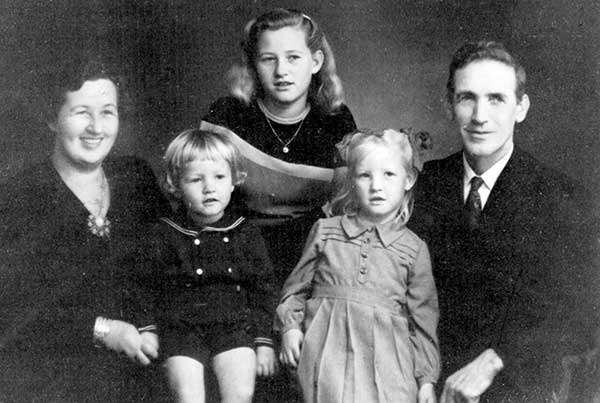
During their visit to Vestfold in the summer of 1948, there was time for a trip to photographer Jørgensen in Sandefjord. From left to right: Alvhild, Knut, Anne, Marit and Kristian Stampa.
A good part of the profits from Galápagos would be reserved for a new Galápagos expedition. The dream of a Norwegian canning factory was to be realized through the united company “Stillehavs-Fangst” (“Pacific-Catch”). Prime movers of the project were Arne Chr. Karlsen and Lars Karterud.
Karterud is the same one who participated in the Ulva expedition in 1926, and according to the ship's newspaper,“Gapa-Lagos,” should have his name changed to Kasterud [Kaste in Norwegian means to throw or cast, as in harpooning.] because he so skillfully harpooned a dolphin! After Galápagos he roamed around the world for a while, fished lobster in South Africa, and fought for Finland during the Winter War of 1939. In recent years he worked as a fish merchant in Stavanger.
Arne Karlsen originally came from the fishing hamlet Kiby, near Vadsø. Together with his wife, Svanhild, who came from Kirkenes, he for several years ran the Lille Langerud farm in Abildsø on the outskirts of Oslo. After the war the farm was sold as a housing site for the city, and with the profits they bought a house in Asker (also near Oslo) and a lumber yard in Stavanger on the west coast. Now everything was sold and 100.000 kroner invested in “Pacific-Catch.” Consequently, Karlsen was the financial backbone of the enterprise. During the voyage he would serve as first mate.
The other members of the expedition invested in shares amounting to 5000 kroner and more. In addition to those participating in the journey across, Gordon Wold and several others on Santa Cruz had paid for shares and also ordered equipment they needed from Norway.
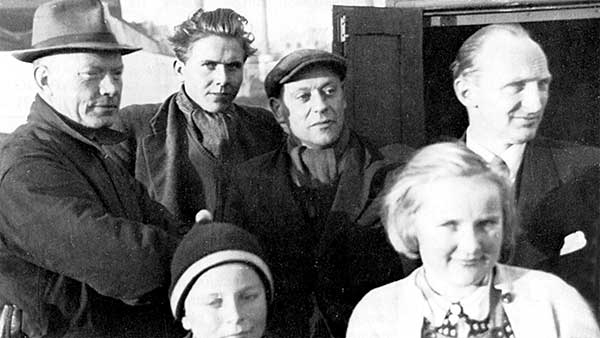
Aboard Thalassa in Stavanger, Autumn 1948. From left to right: two unidentified men, Lars Karterud, Arne Chr. Karlsen. In foreground; Erling Karlsen (9 years old), Arnhild Karlsen (10 years old). Photo courtesy of Arnhild Karlsen Utheim, Oslo.
With the experience of Karterud and Stampa from the Ulva Expedition, it should be possible to avoid most of the mistakes of 22 years ago. The formal petitions for fishing concessions were arranged by the consul general in Quito, who was still Haakon Bryhn, and the Ecuadorian chargé d'affaires, Jorgé Perez Concha, and consul Henry Wilhelmsen in Oslo.
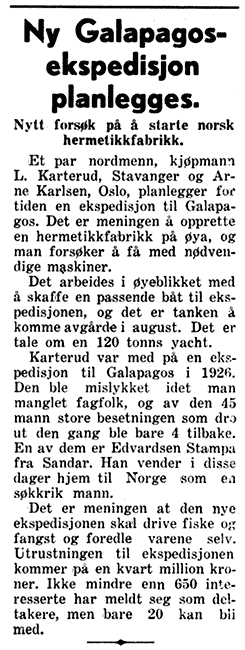
New Galápagos Expedition being planned.
A New Attempt to start Norwegian Canning Factory.
A pair of Norwegians, merchant L. Karterud, Stavanger, and Arne Karlsen, Oslo, are planning an expedition to Galápagos. They intend to build a canning factory on the islands and hope to transport all the necessary machinery.
They are now working on the purchase of a suitable vessel for the expedition, and the plan is to leave in August. They are concentrating on a 120-ton yacht.
Karterud took part in the 1926 Galápagos expedition. It failed mainly through the lack of skilled personel, and of the original 45-man crew, only four are still there. One of these is Edvardsen Stampa from Sandar. Now he is back in Norway as a wealthy man.
The intention is that expedition members themselves shall do all the fishing and processing of goods. The total cost of the expedition is estimated at a quarter-million kroners. No less than 650 interested persons have stated their wish to participate, but only 20 can do so.
The expedition's ship, Thalassa, was a former American pleasure craft of 100 tons gross, built in 1933. During World War II she was used as a military surveyance craft. On the quarterdeck stood a short mast where one could set a small supporting sail, but otherwise she was a genuine motor-cruiser. Twin engines gave a maximum speed of 16 knots.
The captain on board was Carsten Willumsen from Stavanger who, at 55 years of age, was the expedition's oldest member. Previously he had piloted several ships and was known as an able seaman. In addition to Willumsen, Lars Karterud, the Stampa family (with the exception of Anne who would go to school in Norway) and the Karlsen family (parents Arne and Svanhild, with children Skjalg, 14 years old, Arnhild 10, and Erling, 9 years old), the expedition had the following members:
- Ansgar Breivig, first engineer from Oslo,
- Johan Stene, second engineer from Trondheim,
- Hans Hansen, cook from Klosterskogen near Skien,
- Torstein Kvarekval, electrician from Dale in Bruvik,
- Daniel Liadal, store manager from Øystese,
- Bernhard Jacobsen, sailor from Tromsø,
- Hedvig Søberg Olsen, expedition secretary from Oslo.
On Santa Cruz the secretary Miss Olsen will be the teacher of all Norwegian children on the island.
Preparations for the expedition had been going on for some time before the Stampa family returned to Norway. The original plan was for Thalassa to leave from Stavanger in September-October, arriving at Santa Cruz for Christmas.
However, collecting supplies and the many other preparations took more time than was estimated. There were also delays due to the customs authorities demanding duty on the purchase of the U. S. registered ship. Payment was avoided by arranging that the formal purchase of the vessel only would take place upon arrival in Panamá.
Another, more well-meaning authority that caused delays, was the Coast Guard. It claimed that the engines were in poor condition and had to be overhauled at a mechanical work-shop, or, preferably, replaced, before Thalassa would be declared “seaworthy.” Arne Karlsen pointed out yet again that the ship was American, and therefore the Norwegian authorities could not restrain her. Besides, engineers Breivig and Stene were confident that they could get the engines into first class condition themselves.
Only on November 28th was Thalassa was seen motoring out of Stavanger.
But the expedition was plagued with bad luck from the start. After only a few hours at sea the main bilge pump failed, and the same evening found the ship at anchor back in Stavanger. Nevertheless, the Stavanger Aftenblad newspaper announced that:
“Galápagos Travellers Keep up the Spirit
The fog in Dusaviga (off Stavanger) will be forgotten when they sit beneath the palms
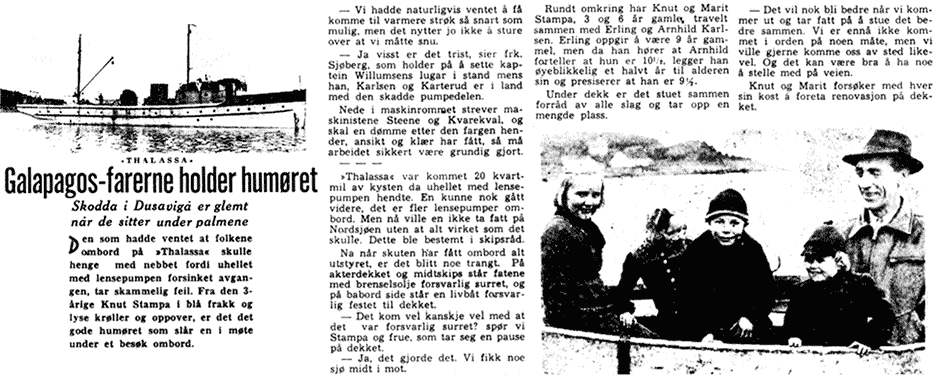
Those who thought that the people aboard Thalassa would be discouraged because a malfunctioning bilge pump delayed their departure were absolutely mistaken. From the three year old Knut Stampa, with his fair curls, and dressed in a blue overcoat, to the oldest, it is good spirit that impresses a visitor to the ship.
—Naturally, we expected to get to warmer territory as soon as possible, but sulking is of no use.
—But of course it is annoying, says Miss Søberg, who is tidying up Captain Willumsen's cabin while he, Karlsen and Karterud are ashore with the damaged part of the pump.
Down in the engine room the engineers, Stene and Kvarekval, are working hard and, judging from the color of their hands, face and clothing, they are doing a thorough job.
Thalassa was 20 nautical miles off the coast when the problem with the bilge pump developed. One could have continued since there were spare bilge pumps on board, but they did not want to tackle the North Sea without everything in working order. This was a decision by the ship's counsel.
Now that all equipment is aboard, it is somewhat cramped. On the stern and amidships, barrels of fuel are securely fastened, and on the port side, a lifeboat is lashed to the deck.
Maybe it was fortunate that everything was so well tied down, we ask Stampa and his wife, who are having a break on deck.
—Yes, it was. We had some of the seas from directly ahead.
Knut and Marit, 3 and 6 years old, romp around with Erling and Arnhild Karlsen. Erling announces that he is 9 years old, but when he hears Arnhild reporting that she is 10½, he immediately adds half a year to his age and says that that he really is 9½.
Stored below deck are provisions of all kinds, occupying a lot of space.
—This will improve once we are underway and get everything properly stored. And then it may be good to have something to do.
Knut and Marit, each with a broom, attempt to sweep the deck.
—During the voyage, won't it be somewhat of a problem to keep the little ones safely aboard, without risk of their falling into the sea?
—Oh, they will quiet down after a few days, all will go well.
—Inside the cabin it is rather cramped but nevertheless cosy.
—There will be more space once we have rearranged things, says Mrs. Karlsen. There is always some disorder at the start but just wait. And we do expect warmer weather pretty soon, and then we will not spend much time in the cabins. We hope to be able to stay on deck most of the time.
Skjalg, who is our ‘ferry man’ is an adolescent who adults consider to be a child, although he considers himself to be an experienced hand. He comes from Kirkenes.
—Just stay back here and freeze, he says when he rows us ashore. I shall certainly enjoy the southern sun and summer.
As I mentioned before, Thalassa can make 16 knots with both engines running, but during the trip will cruise at 10-12 knots. But should there be a need, it is good to have some reserve—the voyage is long. And now all aboard are yearning to get around the Tungeneset [the headland on the NE tip of the peninsula where Stavanger is situated.]
—Next time there will be no return, you will see, Skjalg says as a farewell greeting.—You can rest assured…!
This one repair revealed the need for others, and so Thalassa's departure kept being delayed. The Stampa family then decided that Alvhild and the two children should travel across the Atlantic in a larger ship and wait for Thalassa in the West Indies.
There were several reasons for this. First of all, 6 year old Marit was very seasick during the short trial cruise; secondly, the danger of foul weather was increasing all the time because of the delays, and thirdly, there were several warnings from people who considered Thalassa unseaworthy. The ship had not been certified since her construction 15 years earlier, and according to statements from the Coast Guard, no insurance company was willing to insure the ship, the cargo or the passengers.
Kristian and Alvhild decided that it was wisest to separate the family, and Alvhild, Marit and Knut instead left Sandefjord aboard the whale factory ship Kosmos V.
On December 17th, Thalassa finally leaves Stavanger. On December 22nd they have passed through the most feared stretches. The North Sea, the English Channel, the Bay of Biscay and Cape Finisterre are behind them and they are safe in the harbor of Vigo in Spain. But there have been some difficult times with nothing but bad weather and much seasickness.
While there is still daylight, Christmas Eve is celebrated on deck with a Christmas tree, songs and exchange of gifts. The Spaniards along the pier observe them with amusement. Ten year old Arnhild's best memory of the occasion is a crate filled with oranges—ripe oranges. In Norway oranges are a still rationed luxury. Here she can eat as many as she wishes!
The cook, Hans Hansen, uses the stay in Vigo to write a letter to a friend in Stavanger:
“Around Cherbourg we had heavy pitching seas, and Thalassa sure did show her worth. At the Channel Islands we had the most exciting adventure to date. Because of the high waves we proceeded with only one engine. When we were near the narrow strait between the Channel Islands, it suddenly stopped. Luckily, we had the sail up, which helped to steer the ship, but nonetheless we drifted quickly towards the breakers. We discovered that water had got into the fuel, and we drained off water by the bucketful before the fuel returned. The entire event did not last more than 10-15 minutes—but we sure do not wish for a repeat of those minutes…
“…it has been an adventurous voyage, but I will advise no one to do likewise. The sea is too big for a 100-ton ship. When I stood on the quarterdeck, which is only a few feet above the surface of the sea, I realized how small the ship really is. But Thalassa managed marvellously. She wagged her tail a little and climbed up, no problem How well she copes you can understand from the fact that we did not have a single sea of any size across the deck. When we arrived at Vigo, we had not lost a single board from the deck's cargo.”
This letter is the last known message from the Thalassa expedition. From fourteen of the fifteen people aboard, there will never be more messages whatsoever.
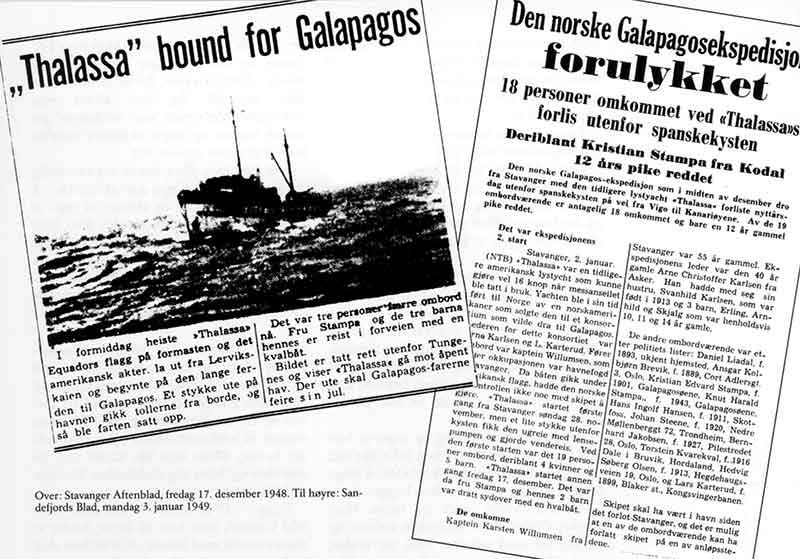
| Stavanger Aftenblad, Friday December 17, 1948:“Thalassa” bound for Galapagos | Sandefjords Blad, Monday January 3, 1949: The Norwegian Galapagos Expedition Wrecked |
|---|---|
| 18 persons died in “Thalassa” disaster off the Spanish Coast Among these was Kristian Stampa from Kodal 12 year old girl rescued | |
| This morning “Thalassa” hoisted the Ecuadorian flag on the foremast and the American astern and left the Lervik quay to start the long trip to Galapagos. A distance away from the harbor the customes officials left the ship and the speed was increased. There are now three persons less aboard. Mrs. Stampa and her three children have gone ahead aboard a whaling ship. This picture is taken outside Tungeneset and shows “Thalassa” heading for open sea. That is where the Galapagos travellers will celebrate their Christmas. |
The Norwegian Galapagos expedition which left Stavanger in the middle of December aboard the former pleasure yacht “Thalassa” was wrecked New Year's Day near the Spanish coast en route from Vigo to the Canaries. Of the 19 persons aboard, 18 are thought to be lost and only a 12-year old girl was rescued. This was the second start of the expedition. Stavanger, 2 January (Norwegian Telegraph Bureau) “Thalassa” was a former American pleasure craft capable of doing 16 knots with the mizzan sail hoisted. The yacht was originally sailed to Norway by a Norwegian-American who sold it to the company planning to sail to Galapagos. The leaders of this company were Arne Karlsen and L. Karterud. The skipper aboard was Captain Willumsen who during the [German] occupation was Harbor Master in Stavanger. Since the ship sailed under the American flag, the Norwegian Coast Guard had nothing to do with the vessel. “Thalassa” started originally from Stavanger on Sunday, November 28, but after a short trip along the coast, the bilge pump failed and they returned. During the first start there were 19 persons aboard, including 4 women and 5 children. “Thalassa” started for a second time on Friday, December 17. At that point Mrs. Stampa and her 2 children had left to go south aboard a whaling ship. [List of those who perished is not included here. See names, above.] The ship is supposed to have visited harbors since leaving Stavanger and it is possible that one of the participants may have left the vessel during one of these stops. |
On New Year's eve, Thalassa begins the voyage from Vigo to the Canary Islands. The weather is bad and it soon becomes worse. It quickly gets very dark as a full blown gale is raging. Between one and two o'clock at night some fishermen in the village of Bayona are alarmed to see the lanterns of a small ship heading out to sea in the awful weather. Unable to do anything to help, they witness how the ship is pushed off course in the narrow shipping lane and thrown against the El Lodo rocks.
The lanterns immediately go out and Thalassa breaks in two. The fore part disappears into the depths within seconds, the stern section remains on the reef for a few minutes before it is also washed off and sinks.
Arnhild Karlsen is staying in the stern cabin together with her mother and two brothers. They try to sleep, but even below the movements are violent and several times she nearly rolls out of her bunk. She lies listening to objects sliding back and forth on the floorboards in synchrony with the ship's pitching and rolling.
Suddenly there is an enormous crash and the ship heels over more than ever before. There is a mixture of creaking and thumping noises as Arnhild is thrown against one of the sides of the cabin. She hears the sound of water pouring in and her brothers screaming. Then her father rushes down the steps and shouts for them. Even before he says so, she understands that they have hit a reef. They must all get up on deck immediately.
Her father helps her up the steps, her mother follows with Erling. Skjalg manages on his own. Even before they start to climb, they wade in water, and from the open door water gushes over them. On the sloping deck she sees that only the stern section of the ship remains—the front half has disappeared.
Her father fetches life-jackets from a chest on deck. All the time the seas wash over them. Arnhild is naked; the wind blows wet and cold. She is scared and shivering but does not cry. She gets a glimpse of Kristian Stampa, clinging to something a few feet away. Her father struggles with the straps of the life-jacket. Her mother is trying to put a vest on Erling.
Finally, her father has finished securing the life-jacket and shouts that he will tie her down so that the waves cannot wash her away. But before he can do this, a huge sea buries them completely.
Arnhild is torn away from her father. She feels herself rolling against rocks and protects herself with outstretched arms. She goes under; the sea is boiling and roaring everywhere. She needs air. Finally she gets her head above water and can again breathe. She thinks how strange it is that the water feels warm and welcome. Up on the ship it was a so cold and evil…
Arnhild does not know how long she remains in the water, but it is still night when she is washed up on a beach and manages to crawl far enough to be out of reach of the foaming waves. There she falls asleep, battered and exhausted.
When she awakes it is light. A short distance away is a small stone house. Her entire body aches as she walks slowly toward the house. There she meets two soldiers. They are startled to see her and say a lot that she does not understand. She is embarrassed to be dressed in nothing but a life-jacket, but when the soldiers hand her a pencil and paper, she understands that she should write her name.
This she does but it is difficult and hurts because she has abrasions and cuts on arms and hands, and the paper is stained with blood and sand. Now she is quickly wrapped up in a blanket and carried to Captain José María Nieto. He is chief of the Bayona Coast Guard. [Bayona is a small fishing and tourist village west of Vigo, Spain.] His wife takes care of Arnhild's injuries and gives her a bath, food and new clothing.
On Monday January 3, 1949, Norwegian newspapers carried news of the tragic shipwreck on their front pages. According to Verdens Gang and the Stavanger Aftenblad, Arnhild should have said that one of the crew of Thalassa swam ashore with her and therefore saved her life. While she was thrown up on the beach and reached safety, he was apparently washed away.
In 1992, 44 years later, Arnhild Utheim, as she is now known, cannot remember that anybody swam with her or that she should have said something to this effect. But she remembers that three bodies were found on the beach and she had to identify them.
The three were Arnhild's mother, Svanhild Karlsen, Miss Hedvig Sødal Olsen and Ansgar Breivig. Later, Erling Karlsen and Kristian Stampa were also found. All were buried in Bayona.
In addition to the loss of 14 persons, Thalassa took with her into the depths fishing gear and fish canning equipment valued at more than 250,000 kroner. The ship itself and other equipment were worth 400,000 kroner—a considerable fortune in 1948.
Nothing was insured.
From the Monday, January 3, 1949 edition of Vestfold: The boat pictured below is the Stampa family's Falcon; originally a 24-foot motorboat which was shipped about Ulva. Stampa completely rebuilt the boat in such a manner that it became a seaworthy 30-foot motor-sailer.
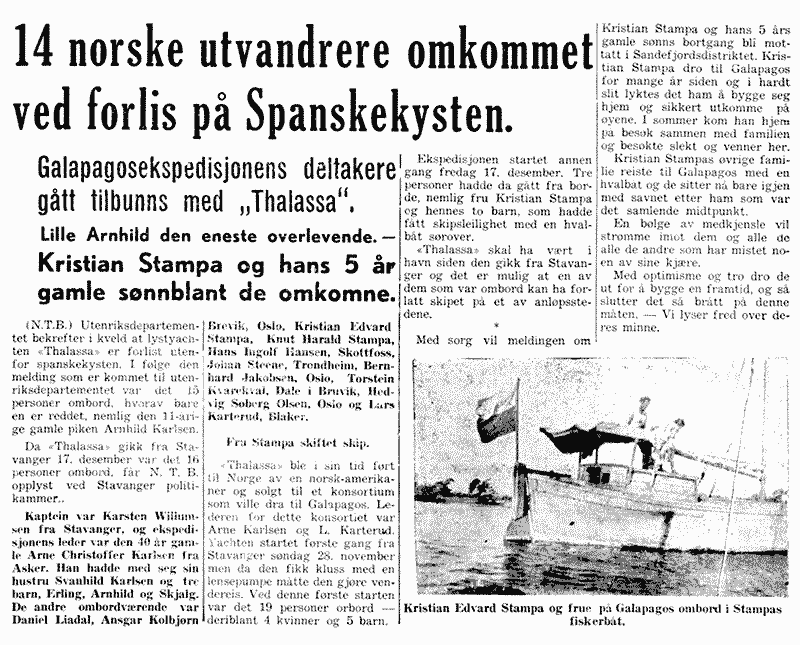
14 Norwegian emigrants perished in Shipwreck off the Spanish Coast.
Members of the Galapagos expedition drowned in the loss of “Thalassa.”
Little Arnhild is the only survivor.—
Kristian Stampa and his five-year-old son among the perished.
(N. T. B.) The Foreign Service Department tonight confirmed that the luxury yacht “Thalassa” has been shipwrecked on the Spanish coast. According to the report received by the Foreign Service Department there were 15 people aboard, of which only one is saved, the 11-year-old girl Arnhild Karlsen.
N. T. B. was informed by Police Headquarters that when “Thalassa” left Stavanger, December 17th, there were 16 people aboard.
The captain was Karsten Willumsen from Stavanger, and the expedition leader was the 40-year old Arne Christoffer Karlsen from Asker. He had with him his wife Svanhild Karlsen and three children; Erling, Arnhild and Skjalg. The others aboard were Daniel Liadal; Ansgar Kolbjørn Brevik from Oslo; Kristian Edvard Stampe, Knut Harald Stampa, Hans Ingolf Hansen from Skottfoss; Johan Steen from Trondheim; Bernard Jacobsen from Oslo; Torstein Kvarekval from Dale in Bruvik; Hedvig Søberg Olsen from Oslo, and Lars Karterud from Blaker.
Mrs. Stampa changed ship.
“Thalassa” was brought to Norway by a Norwegian-American and sold to the company which wanted to emigrate to the Galapagos.
Leaders of this consortium were Arne Karlsen and L. Karterud. The yacht first started from Stavanger on Sunday, November 28, but trouble developed with the bilge pump and was forced to return. There were 19 persons aboard, of which four were women and five where children. The second start of the expedition occurred on Friday, December 17. Three people had left ship, namely, Mrs. Kristian Stampa and her two children, who obtained passage on a whaling ship.
“Thalassa” is supposed to have entered harbors after she left Stavanger, and it is possible that one of the passengers left the ship at a port of call.
It is with great sorrow that the news of the passing away of Kristian Stampa and his 5-year old son is received in the district of Sandefjord. Kristian Stampa moved to the Galapagos many years ago, and with hard work he succeeded in building his home and providing a sure income in the islands. This summer he came home with his family to visit friends and relatives.
The other members of Kristian Stampa's family travelled to Galapagos aboard a whaling ship, and are left to endure the great loss of the focal point of the family.
A wave of sympathy will flow to them and all the others who lost their loved ones.
With optimism and faith they left, hoping to build themeselves a future, and instead it ended this way so suddenly—We pray that they may rest in peace.
[Caption under ship photo] Kristian Edvard Stampa and wife aboard Stampa's fishing boat.
On January 3, 1949, the Foreign Ministry sent the following telegram to the Norwegian consul in Willemstad, Curaçao, West Indies:
“PLEASE CONVEY TO MRS STAMPA JUST ARRIVED WILLEMSTAD KOSMOSFIVE THAT HER HUSBAND PERISHED IN MOTORYACHT THALASSA SHIPWRECK OFF SPAIN DECEMBER 31ST STOP FAMILY SENDS SINCEREST CONDOLENCES AND DESIRES INFORMATION IMMEDIATE PLANS STOP PLEASE GIVE HER AND CHILDREN NECESSARY ASSISTANCE:
FOREIGN MINISTRY”
Alvhild Stampa could not bear to continue to Galápagos but returned to Norway. After the loss of Kristian, by 1985, when this was first written, none of the Stampa family had been back to the Galápagos (but in later years Knut Stampa has been a regular visitor and his sister Anne has also been back). For several years, Falcon lay lonely and abandoned on the beach of Santa Cruz, waiting in vain for her owner. The house, Arena Blanca—white sand—is still standing (1985) but in sad disrepair.
It may be a poor consolation that although the charts still print the name Bahia Salina, most people today refer to this pretty bay as Stampa Bay. Would it not be an appropriate gesture in honor of the Norwegian pioneers of Galápagos for the official name to become Bahia Estampa?
“Plantation at your disposal”
Jacob Hersleb Horneman's father was a “tall ship” captain from Trondheim. Later he became lighthouse keeper of the northernmost lighthouse in Norway, on the tiny Fruholmen island in Finnmark. [Finnmark is the northernmost and largest of Norway's 20 counties. It borders on the Russian Republic, Finland and Sweden.]
Here, Jacob, an only child, grew up surrounded by untamed, harsh nature, with a minimum of contact with other children, and also little contact with adults other than his parents and a governess.
The boy was very intelligent. As soon as he could read, he became a bookworm, thirsting for knowledge. His reading made him think and reflect and wonder about the many strange aspects of human existence. As he became older, Jacob made a habit of underlining passages in his books, filling covers, blank pages and margins with detailed comments, as if he were communicating with them.
Dreams became an inevitable consequence of the lonely life and all the reading. Jacob had visions of finding gold nuggets in river beds, of silver veins deep in the barren mountains, and of an easier life in a warmer country far away from Fruholmen Lighthouse and Finnmark.
Jacob Horneman never found the silver vein, but at 37 years of age he came to the Galápagos. There he found another kind of riches.
After schooling in Hammerfest, Jacob studied geology at N. T. H. (Norges Tekniske Høgskole). [“N. T. H.” is Norway's Technical University, now part of Trondheim University.] With his interest in the earth's hidden minerals and metals, any other field of study was unthinkable.
After graduation he ended up in the Arctic islands of Svalbard, geologically speaking the country's most virgin territory.[Svalbard is the name more commonly used in maps and gazetteers. Spitzbergen is the name of the main island.] Compared with this Fruholmen was a vacation paradise! For six years he worked at various iron and coal mines mostly as a caretaker. He had plenty of opportunities to roam around and search for the big lode.
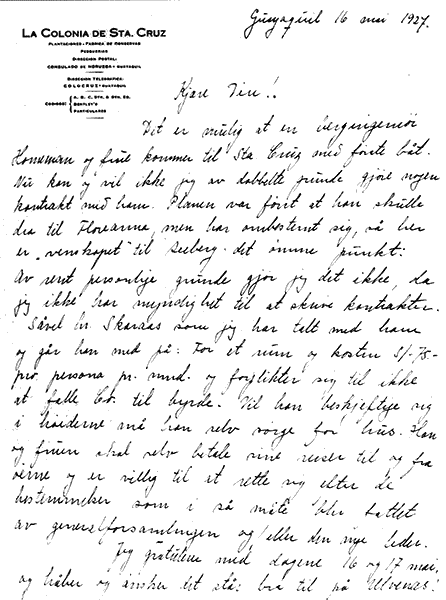
The first time that we hear about the Hornemans is in this letter from Sverre Kiserud, the representative of La Colonia de Santa Cruz in Guayaquil, to Thorolf Østmoen who, for the time being, is leader of “Ulvenæs” [“Wolfhill”; the Norwegian name for what later became Puerto Ayora]. The couple got underway from Guayaquil with the flag-decorated “Isabela” on May 17, the Norwegian National Day. After a visit to San Cristóbal, they arrived at Santa Cruz on May 29.
Guayaquil, May 16, 1927
Dear Friend!
It is possible that mining engineer Horneman and wife will arrive at Santa Cruz by first boat. For two reasons, I cannot nor want to enter into a contract with him. The original plan was to go to Floreana, but he changed his mind, and here the “friendship” to Seeberg is a point. For personal reasons I will not do it and also I do not have the authority to write contracts.
Both Mr. Skaraas and I have talked to him and he agrees to the following: For one room and meals, 75 sucres per month per person, and he must not become a burden to the Company. If he wants to settle in the hills, he will have to provide his own house. He and his wife will have to pay for their voyages between the islands, and agree to follow regulations established by the General Assembly or the new leader.
I salute you on the 16th and 17th of May [Norwegian National Days] and wish that all is well at “Ulvenæs.”
Letter courtesy of Kanen Østmoen, Drammen
When the magazine Vi Menn published an article about Horneman in 1963, the editor received a letter from Olav M. Pedersen in Tromsø. He had also worked in Svalbard in the 1920's and he wrote, among other things:
“That Horneman is still alive was a surprise since I thought that he had gone from this world long ago!
“Horneman rowed and tramped around Spitzbergen mostly as a vagabond, both in winter and summer. Many a time he returned to the mines more dead than alive.
“I remember the summer of 1924 when he arrived half dead in Grumann City, wet and frozen. It appeared that he had walked along land-locked coastal ice and at the foot of a mountain had accidentally slipped into the sea. How he managed to get ashore again is still a mystery. There was ice everywhere, even though it was the end of May.
“Horneman was a courageous chap and many legends were told about him by hunters and construction workers on Spitzbergen, Svalbard in the 1920's….”
Author Mikkjel Fønhus was also in Svalbard and met Horneman. He collected stories about this loner, who, regardless of the season, braved the elements looking for valuables in rocks and gravel. In “Men Below the Northern Light” (1948) Fønhus introduces him as Mr. Lederup—caretaker in the English mine “Arctic Coal Co.” Lederup is described as a tall, thin man of few words. Mostly he looked like a savage, but when he spoke he revealed the voice of a cultivated man, one of good background and education. His face was mostly hidden behind a huge beard, with intelligent, slightly restless eyes behind the glasses.
In the Arctic wilderness he walked across the mountains and rowed along the fjords in weather that kept others inside. On one occasion he capsized his boat, lost provisions and rifle, but still did not abort his trip. Instead, he killed birds with stones, and as the saying went at the time, lived on “sea gulls and driftwood.”
When Horneman was determined to complete a project, nothing would change his mind!
And this is also how it was in Santa Cruz. Often it was more his determination rather than skill which drove him toward his goal. As rumors spread in Svalbard that Horneman had ended up on the Galápagos Islands, far away in the Pacific Ocean, it was said that “One day Horneman was out rowing with some other men when the boat suddenly capsized and Horneman disappeared. In spite of a thorough search and dragging for the body, the man was gone. Six months later he emerged in the Galápagos!”
Jacob Horneman was also a romantic who women found very attractive. His first wife was named Anna Gauslaa, a nurse from Lillesand. She was willing to follow him to Svalbard, Santa Cruz—anywhere.
Jacob's interest in Galápagos derived from articles by enthusiastic Ulva participants. He and Anna first arrived in Santa Cruz in May 1927. They settled near Fortuna, where they built a house and lived by farming. But the tragic accident with Birger Rostrup's death, who Anna nursed until he died, and the difficulties when Robert was born, put a heavy strain on Anna. Later the boy developed tetanus and barely survived. When a new baby was expected, at the same time that the island was being depopulated, she wanted to go home to Lillesand. By this time they had been on the island for two years.
As soon as rumors circulated that the colony on Santa Cruz had started up again, Jacob wanted to return. Meanwhile, Christian, who was born in Lillesand, remained with his grandparents, while the other three, Jacob, Anna and Robert, spent a new two year period on Santa Cruz. But in 1933, Anna Horneman wanted to go home for good. By now she had enough of Galápagos. Jacob was equally determined to stay, so they ended in divorce.
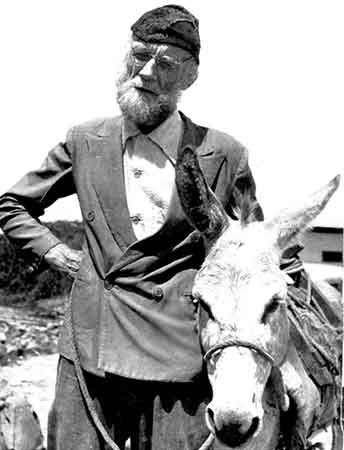
After an interim as a miner in South America and Africa, Jacob returned to Santa Cruz with a new wife—a dancer, 20 years younger than himself. Else Jørgensen came, had a brief look, and left again. Galápagos was not her notion of paradise. She demanded a divorce and opened a hairdressing salon in Guayaquil instead.
Geology engineer Jacob Hersleb Horneman from Finnmark was, for more than 40 years at Santa Cruz, a personality among personalities. And here he is with his faithful donkey “Mikkel.” Photo courtesy of Erling Brunborg, 1958.
A new mining sojourn brought Jacob Horneman to England in 1938. There, a friend of his, Florence, told him that she knew a woman in Frankfurt who would be suitable for him: a secretary skilled in languages and with an adventurous spirit. Her name was Elfriede Engelmann.
Jacob sat down and wrote to this woman who he has never met:
“I beg to offer you a guaranteed position as colonist in the Norwegian company on Santa Cruz Island, and place at your disposal a small plantation and a small house. Your eventual neighbors, men, women and children, are all Scandinavians, but some of them speak English. They are the best people on the entire island!
“In fact, here we find only nice people, there are no dangerous animals, no malaria or contagious diseases. You will feel much safer there than I do in London—neither airplanes nor submarines can trouble you.
“The climate is as healthy as anyone could wish for, and life on the island gives both energy and strength. The equatorial line crosses the islands, but the cold current from the South Pole makes the climate comfortably mild, like an ordinary summer in England. Every morning you will awaken fresh and fit and full of energy for a new day, which you may spend in the garden, or on horseback, riding to the beautiful sandy beach for a fishing trip.
“In the mountains one has a magnificent view and finds many strange rock formations that awaken the fantasy. Bringing a tent, one can experience unforgettable hours around a small bonfire with a mug of coffee. Such excursions you can take as often as you wish, and you will enjoy life more than most people in the world.
“I mentioned the plantation. It is not big but there are lots of fruits and vegetables at your disposal. Also, we have plenty of poultry, two donkeys for transportation, a saddle horse well equipped for your use. When visiting other places on the island, one has to use a horse or a donkey.
“Otherwise the farm produces most of what you may require for a living. What money is needed for clothing, fuel, and things like that, we obtain from the coffee plantation which surrounds the fruit garden. But you will get plenty of help at harvest time. The Norwegian consul in Guayaquil will help to sell coffee which cannot be sold on the islands.
“The house has two stories and an attic, and is equipped with both windows and mosquito netting. A cast-iron stove with an excellent baking oven is useful for making bread. Water tanks are located right by the kitchen door. It rains sufficiently, often during the night. Rainwater, which is collected from the roofing sheets, runs directly into the tanks and is not contaminated with dust.
“Besides chicken on the farm, I can provide enough meat from wild pigs. We go hunting several times during the week, mostly to provide cooking fat. In this way both hunting dogs and I get more meat than we need. I expect we can also get Ecuadorians for this kind of work.
“Bananas are the most common fruit and are produced in great abundance. They are fried or baked or used in other ways. From root vegetables or tubers we produce an excellent flour which is suitable for baking bread and cakes. Besides bananas there are plenty of oranges, lemons and figs in the garden. You can pick oranges from your window if you like!
“The house is situated at the edge of a terrace. From there you have a view towards the forest below, to the beach, and far away to the other islands, with their high blue mountains….”
Elfriede read this slightly camouflaged marriage proposal several times. After a short exchange of letters, she travelled to London to meet the plantation owner. On returning to Frankfurt she had a new surname and a Norwegian passport. She quickly packed her belongings and went on a honeymoon via Liverpool and Guayaquil to Santa Cruz.
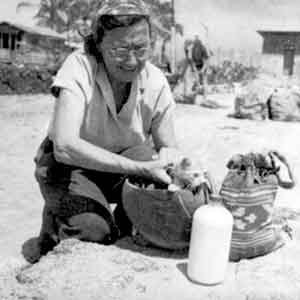
The new Mrs. Horneman was at first taken aback at finding everything so wild and untamed. Villa Villnis was overgrown after a two-year absence, but the house was charming and the view as splendid as Jacob had said. Otherwise, she soon realized that life on Santa Cruz was slightly less romantic and a lot more demanding than the description in Jacob's letter of proposal.
German Elfriede Engelmann took out Norwegian citizenship when she married Jacob Horneman. The kitten is transported in a calabash. Photo, taken in 1958, courtesy of Emil Petersen, Oslo.
“Well, I'd better start,” said Elfriede. And later she adds:“After 20 years I still had not finished!” Free time was rare, vacations unknown. Trips to the beach were mostly with donkeys laden with what they were able to produce. Money was scarce except for the period when the Americans occupied Baltra. It was mostly a barter economy, items being exchanged with other islanders, and it remained like this until the late 1960's.
In 1940, Friedel was born on the second floor of Villa Villnis, and five years later Sigvart arrived. No midwife, no doctor, was present. With Friedel's birth, the parents became known as “Mutti” and “Vati” to everyone. Villa Villnis was out of the way but the house was always open to neighbors and guests. The social interactions provided some of the dearest memories.
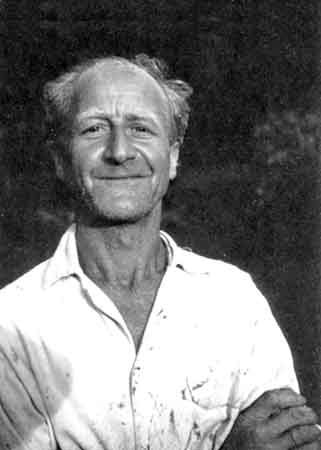
Innumerable hikers, sailors, students and scientists have sat around in Mutti's kitchen. Here they have eaten homemade delicacies, discussed politics and religion with the stubborn Vati—or played chess with him upstairs. Some of those who have enjoyed their visit with the Hornemans include Thor Heyerdahl, Per Høst, Erling Brunborg, Roger Tory Peterson, Robert Bowman, Peter Scott, David Lack, and Farley Mowat.
It soon became obvious that Vati was an impractical dreamer, not very adept with tools and equipment. But he was good at getting others to do what he himself could not do, and he had the will and endurance necessary to survive and fight wilderness and feral pigs, mosquitoes, termites and fire ants.
Often when he left in the morning with his machete in hand he would also take along a book and pencil. Typically one would find him seated under a tree, deep in thought in meditation and busy scribbling in the margins. Vati was lucky to have found a woman who was used to hard work and who was also attracted to this independent life.
Håvard Henriksen from Hønefoss came to Santa Cruz early during World War II and married the Swedish woman Saimy, widow of John Lundberg. They built themselves a nice house surrounded by well-kept fields. They called the farm “Rancho Grande.” The two of them were vegetarians. Moreover, Henriksen was a fresh air addict. His bed was specially built so that he could sleep with his head protruding through a hold in the wall, protected against rain by an overhang of the roof, and with mosquito netting at the sides. When Saimy fell ill in 1960, the family moved to Norway. Håvard returned and tried chicken farming near Bahía Tortuga, but gave up and later on lived in the Canary Islands. Photo, taken in 1958, courtesy of Carl Emil Petersen, Oslo.
It was the fate of Galápagos-Norwegians that their children wanted to leave the islands. This was partly the parents' fault because always they talked about “Back home in Norway.” And May 17, the Norwegian National Day, was more important to celebrate than Galápagos Day, February 12. [May 17th commemorates Norway's adoption, in 1814, of its modern constitution. Instead of military parades there are children's processions with singing and bands.]
The children grew up accustomed to an environment of giant tortoises, huge wild boars, exotic forests, papayas and magnificent frigate-birds. They longed for the world they had read about in newspapers and weeklies, and which adults talked about. Vati was a masterful geography teacher. He made globes out of large calabash gourds and told of his search for diamonds in the Congo, digging for gold in Colómbia, and mining iron and silver on Svalbard.
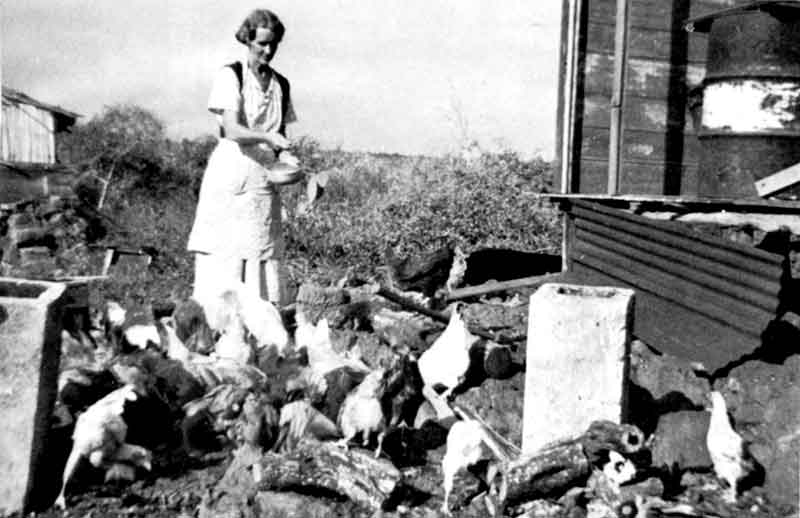
Solveig Rambech, a good friend of Elfriede Horneman, married Anders Rambech in Guayaquil in 1936. After about 10 years on the chacra (farm) in the highlands, they moved to this house near Pelican Bay. Here Solveig feeds the chickens. Photo taken about 1960, courtesy of Elina Rambech, Oslo.
In 1964 Jacob became ill and his daughter Friedel accompanied him to the hospital in Guayaquil. It was crowded and expensive, so when Jacob was slightly better, they continued on to Norway.
Friedel never returned to Santa Cruz. For her, Norway was the dream land.
About the same time, her brother Sigvart also left Galápagos for good. He settled in California.
But Jacob wanted to go “home” again to Santa Cruz. As for Mutti, she somehow managed alone, even though her hip joints were failing. Jacob—with the help of his son Christian—obtained a room at Betania Sanatorium in Malvik near Trondheim, but considered himself far too active to remain a passive pensioner in Norway. For a long time the 75 year old tried to get a job. He was determined to work his way back to the Galápagos, but butted his head against regulations and complained about the red tape of post-war Norway.
A cash gift from the Norwegian Engineering Society was his salvation. In 1966 he was back on the islands. Mutti was standing outside Villa Villnis and waiting when he returned. With white beard and hair flowing he walked the avenue of avocado trees and coconut palms, which the two themselves had planted, and sang “It's a long way to Tipperary.” Mutti limped with two sticks into the house behind him, while she laughingly shook her head.
Scarcely three years passed, before the 79 year old Vati reluctantly had to face the truth. The two could not manage alone any more. His strength was failing, Mutti's arthritis needed medical attention, and both missed their children and grandchildren.
A life's work had to be abandoned. The property was sold, and in 1969 Elfriede and Jacob Horneman left Galápagos for good and headed for Norway and Finnmark. They settled with Friedel —whose married name was now Vonka— and her family. In 1976 Jacob's circle of life is completed. He dies in Karpdalen, Kirkenes, near the Russian border, north of the Arctic Circle, and not far from his childhood's Fruholmen Lighthouse.

| Left: Thor Heyerdahl's archeological expedition was mounted in 1953 because of a report of a tiki (stone statue of a diety) in the highlands of Floreana. When Heyerdahl and his group arrived they discovered that the head was sculpted, not by native Americans or Polynesians, but by Heinz Wittmer! They took the event in good spirits. The statue stands immediately adjacent to the pirate caves. The man in the picture is José David Rodriguez. He was a fisherman—originally with Bruun aboard Norge and later with Nuggerud aboard Dinamita. Photo by the author in 1985. | Right: He who laughs last, laughs best! The Heyerdahl expedition discovered abundant evidence of prehistoric visits, probably by Inca Indians who reached the islands in balsa rafts equipped with a sail and a retractable keel. In front: Eric Reed (USA), Thor Heyerdahl and archeologist Professor Arne Skjølsvold. Behind, their guides in Galápagos: Karl Angermeyer and Erling Graffer. Photo courtesy of Arne Skjølsvold, Oslo. |
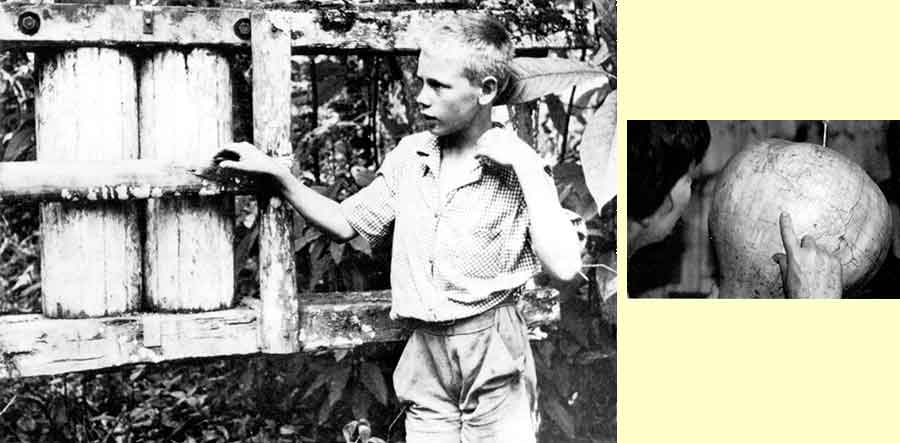
| Left: Thirteen-year-old Sigvart Horneman beside the then old homemade sugar press belonging to Sigurd Graffer. Photo taken in 1953 courtesy of Erling Brunberg, Oslo. | Right: One of the calabash globes made on Santa Cruz by Jacob Horneman, now hanging in Friedel's home in Karpdalen (Karp Valley) near Kirkenes. Photo by the author in 1985. |
The Guldberg Family
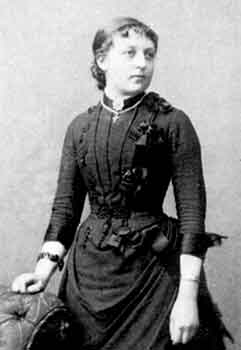 The youthful Laura Gulberg, whose maiden name was Hjerkin. After her death, the widower Thorleiv decided to emigrate.
The youthful Laura Gulberg, whose maiden name was Hjerkin. After her death, the widower Thorleiv decided to emigrate.
In the second half of the nineteenth century, the Christiania physician, Carl Johan Guldberg, worked as a missionary doctor in Madagascar. There, in 1880, he had a son who was named Gunnar Thorleiv. In 1889, after many years in the tropics, Dr. Guldberg was employed as a district doctor for Lesja and Dovre in Gudbrandsdalen in central south Norway.[Dovre is a mountainous area, home of “trolls” as in Grieg's “Home of the Mountain King” of Peer Gynt suite.]
Thorleiv wanted to become a farmer and as an adult he purchased Nordgard Hjelle farm in Dombøs, Dovre. Married to Laura Hjerkin, he had four children; Liv, Frithjof, Snefrid and Karin.
In the 1920's life on the farm gradually became harder and as the income decreased it felt more and more like pointless toil. Thorleiv came to dislike his work intensively, complaining about the harsh Norwegian climate and the cold, and dreamed of returning to his childhood paradise.
When he became a widower, he decided to make a clean break. He wanted to return to Madagascar, but now Galápagos fever was raging throughout the country. In the newspaper Gudbransdølen, Thorleiv saw the advertisement for Harry Randall's “Galápagos Expedition.” He discussed the matter with his children—who would like to accompany him to the Promised Land? [The Gudbransdølen newspaper, founded in 1894, was merged with Lillehammer Tilskuer as the Gudbransdølen and Lillehammer Tilskuer or G & L for short.]
None of them had married and settled down yet, and with the exception of Liv, shared their father's wish to emigrate. Liv was dedicated to her vocation as a nurse and wanted to stay. In spite of warnings from the rest of the family, Thorleiv signed on himself and his three children for Randall's 1926 expedition. The farm at Dovre was sold for 40,000 kroner. After paying mortgage debts and 12,000 kroner to the expedition, not much cash remained. Snefrid had saved some money, but most of it was also used when the expedition proved short of fuel and provisions. She became the sole women shareholder in the Albemarle company and the expedition secretary.
On November 3, 1926, Karin Guldberg's 18th birthday, Albemarle anchored in Wreck Bay, San Cristóbal Island. She looked upon the island as fate's birthday gift; and now it was her island; the fulfillment of a dream world of exotic plants, avenues of orange trees, and pampas where wild cattle and horses roamed. Here were beaches with buried treasures, possibilities for gold and precious stones in the untouched mountains.
Karin viewed everything on San Cristóbal as exciting and positive and ignored the shortcomings which annoyed most of the other Norwegians.
Old Man Dovre and the Russian
Karin's father, Thorleiv Guldberg, was also very content. Admittedly, not on the barren grounds of “Campo Noruego”. He arranged for 50 new acres and moved the house lower down near Progreso. And like the couple Alf and Ruth Ødegård, the Guldberg family learned from the locals: sowed corn, planted bananas and young coffee bushes, and started raising chickens. Coffee plants require 4-5 years before bearing fruit and providing some income, but bananas and papayas he could soon pick at arm's length from the front porch. However, he kept the chickens inside at night, Norwegian style, and in that way he saved himself the trouble of hunting for the eggs.
Thorleiv Guldberg, or the “Old Man Dovre,” as the other Norwegians called him, was more down to earth and did not have his daughter's fascination for hidden treasures. Given enough tobacco and his daily bread, he was content. Because here was the climate he knew from his first childhood in Madagascar—and maybe even better.
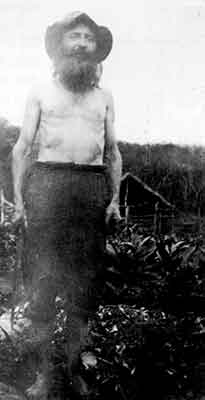 The red-haired Estonian Arthur Senn was an engineer, a linguistic genius and very eccentric. He and Thorleiv Gulberg established a lifelong friendship. Photo courtesy of Robert Ødegård, Tønsberg.
The red-haired Estonian Arthur Senn was an engineer, a linguistic genius and very eccentric. He and Thorleiv Gulberg established a lifelong friendship. Photo courtesy of Robert Ødegård, Tønsberg.Besides, Guldberg found a lifelong friend in the Russian fugitive, Arthur Senn.
The eccentric Russian had already been on the island for a number of years when the Norwegians arrived. He used to work a little for Manuel Cobos at the sugar factory but most of the time he eked out a hermit's existence in the San Cristóbal wilderness.
In his book “Around the World in 80 Years,” Harry Randall relates how Senn lived far from people in a kind of pavilion of wild trees. Here he cultivated some root crops and corn. Otherwise, Randall described him as “a very strange person, who walked around almost naked except for a pair of short and very dirty lady's panties. He was a muscular man with red hair and beard, and if I had met him alone, he would surely have frightened me…”
On San Cristóbal many rumors circulated about Senn. According to one of the stories, he was a Russian grand duke who had escaped the Bolsheviks in 1917. The truth, according to Karin Guldberg, is that he was an Estonian mining engineer, of a good family and education, and was employed by the Siberian railways when the revolution broke out. He escaped first to Tokyo, thereafter to South America where he heard about the pleasant climate of the Galápagos.
When the Swedish author, Rolf Blomberg, visited San Cristóbal in 1934, he met Guldberg and Senn. By then, Senn had moved in with Thorleiv who was on his own after his son, Frithjof, had settled in Argentina. At that time Snefrid was in Oslo and Karin lived in Progreso.
During the seven years that had passed since the house was built of materials brought from Norway until Blomberg's visit, it was nearly hidden in a man-made jungle of banana trees, coconut palms, bushes, papayas and corn.
Guldberg shared the ground floor with his 40 chickens. The Norwegian took care of poultry and tended the coffee bushes. The Russian occupied the second floor. Here he had his bedroom and study. Paper filled with mathematical formulas and calculations were scattered about everywhere. Senn was a genius with languages, including grammatically correct Norwegian. The latter he learned by reading the paper Gudbrandsølen, which he received from Guldberg.
Another peculiarity of the Russian was his habit of always moving his buried money to new sites and that he just as often threatened to commit suicide. About the latter, the“Old Man Dovre” was most unhappy because he assumed that he would be a primary suspect if, one day, the Estonian was found lying there with a severed artery. Finally, Senn promised to abandon plans of suicide.
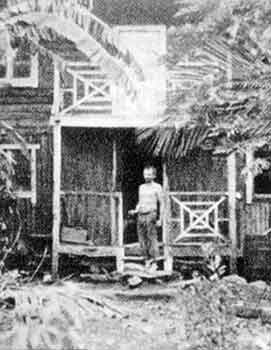
When Snefrid returned to San Cristóbal in 1936, the chickens had to move out. But Arthur Senn stayed, living with Guldberg until he peacefully died one day in the 1950's.
In 1968, at 88 years of age, Thorleiv Guldberg contracted pneumonia and peacefully passed away.
For him Galápagos indeed became what he had dreamed about. A quiet life in harmony with nature.
Thorleiv Gubdberg could almost pick bananas and papayas from his porch. From Rolf Blomberg's book Strange People and Strange Animals, with the author's permission.
Doña Karin
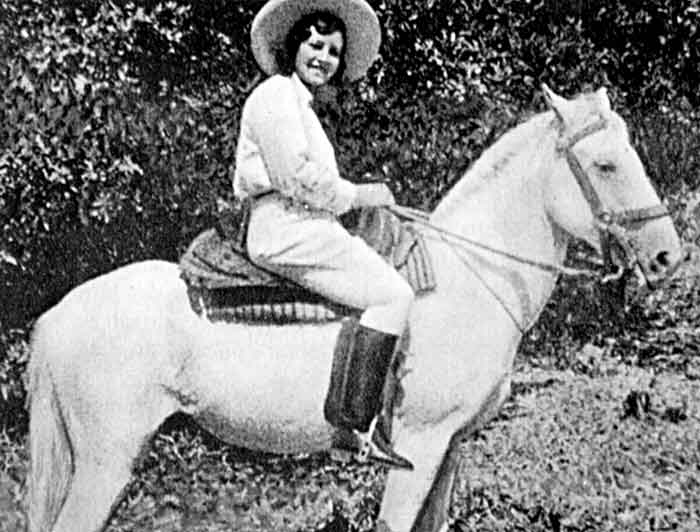
In 1934, Doña Karin Cobos on horseback, the lady from Dovre, was one of the most beautiful women that the Swede, Rolf Blomberg, had ever seen. From Blomberg's book Strange People and Strange Animals, with the author's permission.
For Karin Hjerkin Guldberg, who was 18 years old on the day she went ashore on San Cristóbal, the future provided not exactly a “quiet life.” Nor was she seeking it.
Karin was a good horseback rider even before she arrived in the Galápagos, and soon made a deep impression on Manuel Cobos, Jr. With increasing frequency the two were observed riding together towards El Junco.
At the time, Ecuadorians thought Karin to be a rather liberated women. Normally, it was unthinkable that a woman of good family background would talk, or take a walk, with a man unchaperoned. But here the Norwegian girl rode alone with Sr. Cobos to the island's summit!
Besides, Karin was both intelligent and well read. She knew her Ibsen and other classics, wrote small verses and poems, and could handle an accordion as well as a rifle.
Karin looked upon the ten-year older Don Manuel as a bit of Rudolf Valentino, the contemporary movie hero. Although Manuel was overshadowed by his older brother-in-law, Rogerio Alvarado, he was one of the island's two most powerful men. And as Alvarado spent most of his time in Guayaquil, it was Manuel Cobos who administered the sugar factory, the store in Progreso and the workers on the plantation.
Cobos lived on the second floor above the store in one of the largest houses in the village. Several servants attended his needs. Dressed in riding clothes and sombrero, with a revolver-bandoleer across his chest, the sight of him on horseback was enough to quicken Karin's heartbeat. In addition, he was of good Spanish descent, well educated, spoke French and English fluently, and was named after his famous father of the archipelago's recolonization in 1888.
When Manuel proposed marriage, Karin said yes. She knew about Manuel's mistresses and illegitimate children, but she also accepted the fact that this was a privilege of the upper class. If she got her hero, she was willing to forget his past adventures, even if he once had his own small harem. But Manuel had to promise that if she married him, he would have to be content with her alone.
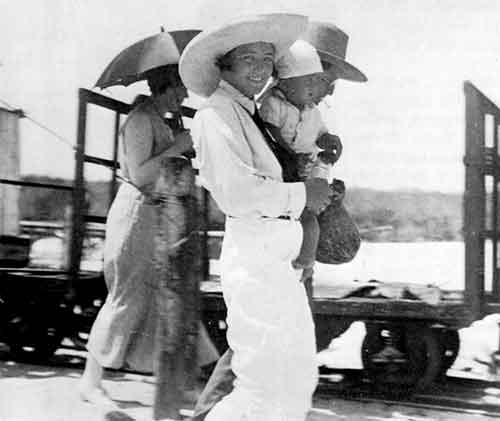
In 1930, Karin Guldberg from Dombos became Doña Karin Cobos de Guldberg of San Cristóbal. On December 23 of the same year the first child was born and given the very Norwegian name of Dagfinn. Later, in 1932, one more son was born Tony, and the daughters Sylvia, Liv and Wilfred arrived between 1935 and 1942, while the sixth and last, Tito, was born in 1945.
Manuel Cobos and his Karin are mentioned in numerous travel accounts. Galápagos was, and still is, an attraction for scientists, adventurers and yachtsmen. When they arrrived in Wreck Bay they would usually seek out Manuel and Karin and satisfy a mutual need for social contact.
Karin and Manuel Cobos with two-year old Dagfinn, Wreck Bay, 1932. Photo courtesy of Robert Ødegård, Tønsberg.
To meet two such romantic persons, very much alive, among the cacti and lava, appealed to one's fantasy. To ride through tangled forests and across pampas-covered hillsides with Karin and Manuel, followed by an excellent meal at the Cobos' house, would complete a day's adventure, much appreciated by all visitors.
In the wake of visitors there inevitably followed articles and books. The sailor, William A. Robinson, describes his meeting with Karin in 1928 in his book, “Across Wild Seas and Among Wild People,” as follows:
“I greeted Karin outside the small, well kept house in the mountains…. Besides the family, she mixed with the rather frightening workmen and former prisoners who helped her farm. The only thing she had to defend herself, should they attack her with their machetes, was a small pistol. Like a man, she rode around on her plantation where she knew every small plant, each living creature. But how marvelously easy and feminine she was in the midst of this isolated, rugged small community. Here she read the classics of her own and other countries, and wrote short verses and “Pictures of Romance,” as she called them in her halting English.
“We became good friends, she and I, and rode side by side for hours on the island, galloping among the wild horses on the pampas or at a walking pace up the slope. Laboriously the horses climbed to the top of the extinct volcano, El Junco, where the trade winds blew full strength, and where grass was luxuriant and the water cool. Scattered clouds wandered over the sky and below us. Sometimes the sun was hidden and it became cold, but just for a moment…
“…it was late afternoon when we stopped on the way down and turned to get a last glimpse of El Junco at sunset. The wild horses on the highest rim stood out in bold relief like black fairy-tale figures against a red sunset.
“Early in the morning of December 2, we sailed on. We had received provisions of food and drinking water from Progreso, and our friends arrived to say goodby. Karin was the one who left us last. On her arm she had the little kinkajou [a yellowish-brown arboreal carnivore, related to raccoons, with a long prehensile tail, occurring from central Mexico to Brasil.] we had taken along from San Miguel Bay. With her it acquired a better and happier home.
“Inland, in the dusk, I saw Karin catch up with Señor Cobos. Still once more they turned and waved to us. Then they disappeared over the hilltop…”
When Rolf Blomberg visited Galápagos in 1934, six years later, Karin had given birth to two children and put on a little weight, but Blomberg was most impressed. There she was sitting on a white horse, dressed in a white riding suit, the dark-haired women was a most beautiful sight. To him she was “the rose amongst the cacti.”
Husband Manuel was proud of his wife and told Blomberg, “You will have to search for a long time in San Cristóbal before you find a cowboy as steady in the saddle as my Karin!”
In his book, Blomberg, good-naturedly, teases the day-dreamer Karin a little, describing how she was always looking for glittering stones and buried treasures.
The one who could really do with a pirate's treasure was Manuel Cobos. He and Alvarado nearly lost everything to Lorenzo Tous in Guayaquil, another man of Spanish descent. Already in 1929, it was touch and go financially for them, but a few years later, the crisis was inevitable. They lost the schooner, the factory, the store and the plantations.
Tous, rolling in money, had no interest in living on the island or sending able people out to administer for him. Soon the great sugarcane fields and the factory were but a memory.
Through bitter fighting in the courts, Alvarado managed to regain ownership of the schooner and later sold her to the government. In 1933, Cobos also had a number of meetings with authorities on the continent. Aided by legal advisers, he had the house and the coffee plantation successfully returned to him.
After this they somehow managed, but coffee prices fell while freight charges on the schooner increased. As a result, the standard of living suffered.
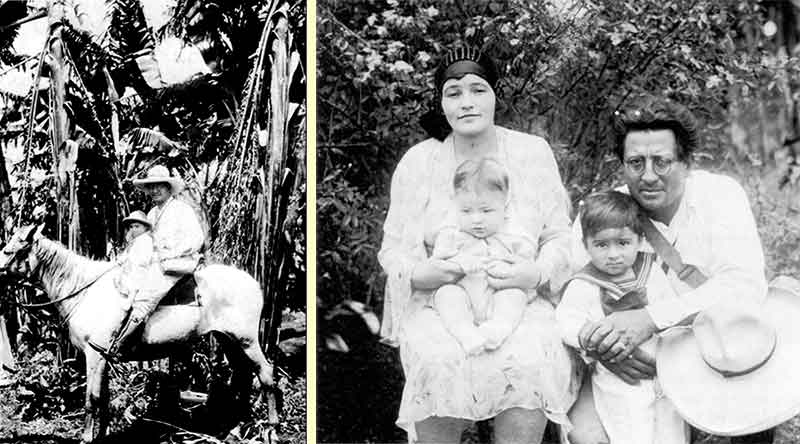
| Left: Manuel A. Cobos and Dagfinn on horseback, Progresso.
Photos courtesy of Robert Ødegård, Tønsberg. |
Right: Karin, Tony, Dagfinn and Manuel Cobos. The photograph was taken in 1933 and was sent to friends Ruth and Alf Ødegård who, at that time, were back in Norway. The picture does not reveal anything about the great finanical crash which had already ruined both Manuel and his brother-in-law, Rogerio Alvarado. |
W. A. Robinson revisited the islands in 1934 and records the decline. But his old kinkajou was alive, and Karin in her riding suit was still the women of his dream. But when he returned for the third time in 1945, he was shocked. He had corresponded with Karin and knew she experienced difficult times but did not realize just how bad things were. The house had not been repaired since his previous visit. Karin was worn out after her last exhausting delivery only weeks earlier. She was surrounded by children and burdened down with problems.
Manuel and she had gradually drifted apart. They were always quarreling, and he had started seeing his old girlfriends. During most of the war he had worked on Baltra for the Americans, was rarely at home, and hardly gave her anything to live on. When Robinson arrived, Karin was depressed and frustrated. Robinson felt likewise and decided never to return to San Cristóbal—he wanted to preserve the memories he had from his two earlier visits…
But when Robinson imagined a bleak future, he was mistaken. As Karin recovered from Tito's birth, she broke with Manual Cobos and started using her maiden name. Karin, the romantic and the dreamer, displayed a willpower that few believed she ever possessed. Gradually an old plan for a cattle ranch was realized, and in 1952 she and the children were able to move into their own wooden house outside Progreso—the first “Pampa Mia.”
Cattle raising went well. They struggled, pinched pennies, and saved. The older children were a great help and gradually the size of their herd of cattle increased. The wooden house was replaced with one made of concrete, this time built high up on the pampas. And this is where Karin and her sister Snefrid still live (1985).
Pampa Mia
Pampa Mia is situated at an elevation of about 500 meters (1600 feet), higher than the other settlements on the island. Even when the coastal air shimmers in the heat, up here there is usually a relatively cool breeze. Night-time temperatures are between 17 and 20 degrees centigrade (62-68 degrees F.), making for an excellent climate. There are no neighbors and the pampas extends rolling and unbroken as far as the eye can see. Only an earth road winds past the house and further up towards the El Junco lake.
Pampa Mia is a little concrete house covered with metal roofing sheets. It is divided into a living room, two bedrooms and a kitchen. Around the house hibiscus and bougainvillea are protected from the chickens and cattle by means of a wire fence. According to Norwegian or North American standards, Karin and Snefrid live very simply. What difference does it make if they are happy? The house does not leak, the windows are intact, they have plenty of fire wood, can carry water from the spring about 40 meters (130 feet) from the house (getting exercise at the same time as they say), and they have enough food. Dagfinn and Tito, Karin's two sons, help to provide the necessary provisions.
On cool evenings in the rainy garúa season they light the “Norwegian” open fireplace in the living room. On the mantlepiece stands a photograph of Cathinka Guldberg, sister of grandfather Carl, known as Norway's first nurse. Next to the picture is a round meteorite stone that they found—one of the house's treasures. On the wall are some darkened paintings, two century-old rifles, and photographs of King Haakon VII and a youthful Olav. [Haakon VII was elected to the Norwegian throne in 1905. He headed the government in exile in England during World War II. Olav is the crown prince of Norway and son of Haakon VII. He was supreme commander of Norwegian forces in 1944-45. Olav V was King of Norway from 1957 to his death in 1991. The present king is his son, Harald V.]. Hanging from the ceiling is a wrought iron chandelier for wax candles. All these items they brought with them on Albemarle in 1926.
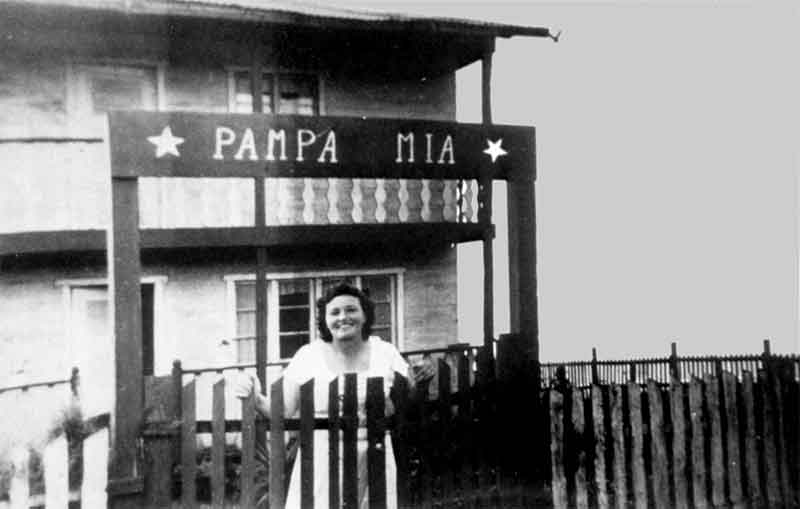 The romantic Karin revealed herself also as a woman with great willpower. In 1945 she was overwhelmed with marital problems, obligations as a mother of six, and financial difficulties. She and Manuel separated. With the help of the children and their father, she established her own cattle ranch. In 1952 she moved into the first “Pampa Mia” near Progreso. Photo courtesy of Karin Guldberg, San Cristóbal.
The romantic Karin revealed herself also as a woman with great willpower. In 1945 she was overwhelmed with marital problems, obligations as a mother of six, and financial difficulties. She and Manuel separated. With the help of the children and their father, she established her own cattle ranch. In 1952 she moved into the first “Pampa Mia” near Progreso. Photo courtesy of Karin Guldberg, San Cristóbal.
When I revisited the Guldberg sisters in the Spring of 1985 [I first met them while circumnavigating on Red Admiral in 1979], the grass on the pampas was withered and brown. Only hardy guava bushes with their green leaves interrupted the monotonous brown. Snefrid did not know how many head of cattle were still alive. They were scattered over a wide area looking for food and water, making accurate counting impossible. Almost every day they found animals that had recently perished. Maybe 800-900 remained. The previous year they had 1600 animals.
It was the drought that killed them. They said it was the worst in man's memory. By Contrast, 1983 was an El Niño year when it rained so much it became a curse. Puddles everywhere, with the road so muddy that it was nearly impassable. After a heavy downpour they could see that in a broad belt around the island, the sea was colored red-brown by soil eroded from the land. Air and sea temperatures rose, and the heat and humidity were depressing. It was like living in a greenhouse.
Everything was green. Flowers were in abundance even down on the normally arid coast. Here the large opuntia cactus trees became waterlogged and suffered! Many crashed down, overburdened by their water-logged tissues and the weight of passion flowers and other creepers. Up on Karin's lush and bright green pastures, the herd of cattle increased considerably.
Now it seemed the time for punishment. Almost no rain had fallen for a year, and hardly any water remained in the crater lake El Junco. The trickle of water through the pipes down to Progreso and the Wreck Bay village at Puerto Baquerizo Moreno has failed, and tank trucks have to fetch water directrly from the lake. The dust they create is a new and previously unknown annoyance.
The spring where Karin and Snefrid get their water has become so small and stagnant that they have to ration every drop. That which is used for drinking and cooking is first filtererd and then boiled.
“The archipelago's real curse,” says Karin, “is the porous volcanic mountain. It does not retain water. Without water, there is no life for us and our domestic animals—only for iguanas and tortoises. We understand why they thrive. Galápagos is the island realm of the reptiles.” She sounds resigned.
The drought is a reocurring phenomenon like El Niño. When Trond Tommelstad was visiting in 1973 and wrote articles for Vi Menn, (a weekly for men primarily) he reported impressions of the drought very similar to mine 12 years later; about 400 dead cattle and a resigned mood at Pampa Mia. Then it also was “the worst drought in man's memory.” Luckily, people tend to forget past hardships.
And here I will stay until I die.
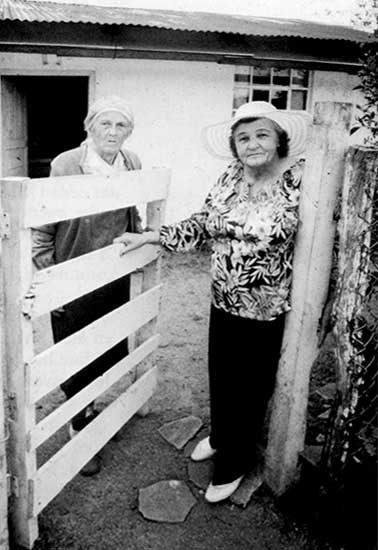
Drought and rain notwithstanding, Snefrid is one who does not want to exchange Galápagos for any other place in the world. Whereas Karin has recently returned from a visit with her daughters in Los Angeles, Snefrid has not been out of Ecuador since 1936, and being 82 years old, has fewer plans than ever for traveling. It has been four years since she was last in Progreso—five kilometers (3 miles) down the road. She thrives on Pampa Mia where she knows each nook, each bush and rock, and each mockingbird and finch that come to her doorway and beg for rice.
From morning until evening she putters around, mostly outdoors, always with the machete in hand: A tree needs felling, a post has to be replaced, wood must be cut for the stove. “Pensioner” is an unknown term on Galápagos. One simply keeps going until one is unable to do so anymore, and only then is one to be cared for and pitied.
Probably Snefrid's active life is also the source of her vitality. She has never shielded her face from the sun's ultraviolet rays. Consequently it is brown and wrinkled like a farmer in the Andes.
1983 was an extremely wet El Niño year, and two years later Galápagos experienced one of the worst droughts in memory. But Snefrid (82) and Karin (77) on “Pampa Mia” hold their own for they know that the pendulum will soon swing back to normal. Photo taken in 1985 and courtesy of Kristian Hosar, Lillehammer.
She is still a Norwegian citizen. But would she return home to Norway? “No, Señor!” She does not want to end her life in an old people's home being fed with a spoon. Besides she was frightened by the situation in Norway as she experienced it in the early thirties. Then she was back in Norway and worked for several years as a clerk in the clothing store of Steen & Strøm in Oslo. Threats of war, unemployment and other miseries are well remembered. No, it had been a great relief to return to San Cristóbal.
“And here I will stay until I die, ¡Exactamente!”
Regarding Karin's six children, only Dagfinn and Tito are still on San Cristóbal. The other four live in Los Angeles. Karin would also like to see the boys leave for North America and a more promising future than Galápagos can offer. But while the four in the USA inherited Karin's ambitions for education and material well being, Dagfinn and Tito are neither Norwegians nor Spaniards; they are Ecuadorians. They do not wish to leave for the USA. They are content with a simpler existence, living mostly like their neighbors, and hopefully avoiding some of the envy and gossip that has pursued Karin throughout the years.
Besides, they have many children, and, in typical Cobos style, some of whom are “within” and some “without.” This situation demands committment if you want to be respected, even in Ecuador.
The coffee plantations of Thorleiv and Snefrid have been taken over by Dagfinn, who, when in absolute need, arranges to harvest some coffee from the overgrown bushes. Why on earth would one wish to strive hard when one can take it relatively easy? Dagfinn lives at Puerto Baquerizo Moreno, where he has a freezer in his living room, papaya and bananas in the garden. Ten children, some grandchildren—all help each other; his welfare in old age is assured by his offspring. Now there is a small TV station at Wreck Bay. Its signal does not reach the other islands, but broadcasts news and video programs for several hours each evening to the locals. What would he do if he were in LA? Progress also comes to he who is patient.
Tito very much agrees. He lives in Progreso in a simple cottage adjacent to his father's former fine house whose wooden skeleton is all that remains. Leading down from what was once the second floor, part of the staircase hangs and sways precariously—a hazard for children who play there. Now the ruin is used only to support a TV antenna. But a new concrete house is under construction, and eventually Tito and his large family will also face the stern demands of the times regarding living standards and hygiene.
When I knock at Tito's door, several children come running. Behind them follows a bow-legged very old man with a book in his hand. He has lost all his teeth, and his eyes are set deeply in their sockets, but they are observant and alive. He notices that I have difficulty in speaking Spanish. “Can I help you, sir? You speak English? Or maybe French suits you better?”
So this is Manuel A. Cobos, 87 years old. A glimpse from the past of a man about whom I have read so much in articles and books —a person I seem to know like an old friend. Karin never talked much about Don Manuel and my communication with his Spanish-speaking sons was too poor. After I first visited the Galápagos Islands six years earlier, I had mistakenly assumed that the man was dead.
In one sense he is dead. He lost both his queen and most of his kingdom. But he still has his old plantation and he still speaks French and English fluently.
And regardless of how much Manuel Cobos, Jr. may have lost in the past, he retains the greatest riches of an old person: Children, grandchildren and great grandchildren, who love him and care for him. I hope he will be granted many more years to tell stories to his numerous descendants about his colorful and fascinating life.
—And afterwards they can go up to Pampa Mia and listen to more …
El Rey de Patatas—The Potato King
St. Cruz, July 10, 1949
Dear Hansen,
Thanks for your letter and enclosures. We have been here now for 14 years and enjoy the free life. Here is a colony of about 7 Norwegian families, all of whom have their own property, larger or smaller. Horneman is our nearest neighbor—about 10 minutes from here, Stampa was a fisherman and accordingly lived at the beach. The inhabitants are either farmers or fishermen.
All who settle on the land receive gratis 20 hectars (50 acres) of his own choosing. The soil has to be cultivated by hand because lava rocks from the dead volcanos are plentiful. We have some difficulties with the wild cattle and pigs, which invade the farmland and create a mess, but the former we can keep out with barbed wire fences and a tree called piñon, which grows unbelievably fast—just push down cuttings close together, and they grow up entangled in the barbed wire.
Pigs can be caught with dogs and rifle—most of the time they are a real blessing because of their meat. They are also captured alive and fattened—butter is non-existent. But most of us keep goats, whose milk is like cream, somewhat different in taste from the goat milk at home. Potatoes and vegetables grow excellently in our season which lasts from May to December. All kinds of fruit such as bananas, pineapple and other tropical fruits we have in abundance.
If one is interested in fishing, there is bacalao with an especially good price—the season is from October to about Easter (Catholics in this country, you see). The price is quite good. The fish are salted and dried—but a boat is necessary, preferably a large motorboat.
There is a company from Trondheim coming down (it will probably take over Stampa's property) to fish and to can. Consul Jensen, of the Norwegian Consulate in Guayaquil, Ecuador, can provide information about Ecuador's immigration laws. There is talk about money that must be deposited at the time of immigration. (But this money is never returned.) But by putting in an application via the consulate the deposit can be avoided. Also, Wilh. Christensen, Ecuadorian Consul of Lille Torvet 1, Oslo, can provide information. Maybe much can be arranged in Norway, since Ecuador has an embassy in Norway (Oslo) now.
Should you have more thoughts about this, just let us know and we shall respond giving you all the advice and suggestions that we can think of concerning what would be advisable to take along and what has to be procured in Guayaquil before one starts traveling to these our beautiful islands.
But it must now be emphasized: Do not forget that this is Ecuador where you are going, because here all statements are like rubber—everything can be bent and stretched until it is to Ecuador's advantage.
And one has to be thrifty and prepared for hard labor, but then everything will work out. Selling our produce is our biggest headache because communication is inadequate and poor. We also have bad roads but our donkeys are incredibly adept.
Arable land is situated about 8 km (5 miles) up in the hills, soil is very good. Rivers or lakes do not exist. We get our water from rain which we collect from roofing sheets in large steel drums. After staying here for a while, one builds concrete cisterns. Some people here have constructed houses entirely of concrete, but there is a tree growing here—lechosa, [Scalesia pedunculata] which is easy to use in construction—whose large trunks are split into planks and usually last 8-10 years. Meanwhile one finds something else or builds another structure similar to the first one.
Well, now I do not know what more there is to write about, but it would be nice to hear from you—but do not enclose any money, [It was common practice to enclose one or two U. S. dollars in a letter to increase the likelihood of a reply.] we will reply, nonetheless. Where in Norway are you from? We are from Rjukan and Arendal—imagine having landed so far away—and thriving— but people vary a lot. Some have arrived and left almost immediately. They could not cope with the initial startup—because that is laborious—preferably young people should be available, but do you not have a son? Maybe he can be as involved as our son is who is now 24 years old, and would not swap for anything in the world. Who knows, maybe a great future lies ahead—look at Hawaii—.
We send our best greetings to your wife in Norway and yourself from
M. Kastdalen,
Santa Cruz, Galápagos,
Ecuador.
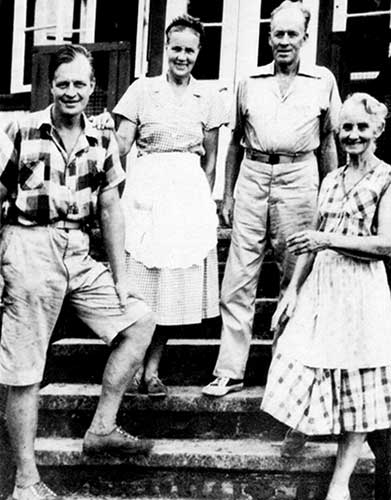
“Hansen,” who received this letter from Marie [“Maja”] Kastdalen, never came to Galápagos. Therefore we do not know if he might have found his paradise on these islands.
But we can conclude that among the Norwegians, the Kastdalens certainly fulfilled their dream about Galápagos.
The writer of the letter, Marie Kastdalen, was born Knudson and came from Arendal. In 1923 she married the carpenter, Thorvald Kastdalen. He grew up on the Kastdalen farm in Askim, but had for several years worked at hydroelectric construction sites in the isolated town of Rjukan in Telemark county. The main desire, however, was to have his own farm, one similar to the one he was born on and which automatically was handed down to his eldest brother.
After two years of marriage, Thorvald and Maja, as she was called, had their only child, a son they named Alf.
On the steps of “Miramar” about 1955. From left to right: Alf, “Maja” (Maria), Thorvald Kastdalen and “Lalla” (Amanda) Christoffersen. Photo courtesy of the Kastdalen family, Santa Cruz.
When the “Krossobanen” [This was one of Europe's first funicular railways for the transport of people.] was completed and opened in 1928, it became more and more difficult to find jobs for the many workers who had rushed to Rjukan. That Thorvald was head of the construction workers' union made no difference; the prospects were gloomy. Although he worked and toiled, pinched pennies and scraped, he could rarely put money aside.
Their friend, Sigurd Graffer, formerly a plumber and laborer in a foundry, was experiencing the same kind of problems. He was also born on a farm and shared Thorvald's longings. His wife's name was Solveig. They had two small sons, Arne and Erling.
The two families met and discussed the merits of emigrating, of finding a place where conditions were better, a place where hard-working people received something in return for their labors. But where? They well remembered the Galápagos fever. How had those who stayed on the islands fared?
They wrote to them and received replies from Stampa, Moe and Horneman. All stated their preference for Santa Cruz. And it was Jacob Horneman's letter in particular that decided the matter:
“A large Pacific island with a handful of Norwegians—20 hectares (50 acres) of land free-of-charge for new colonists… It is my understanding that this is one of the world's most fertile soils. Everything grows. If you feel like eating meat, you need only go into the woods and shoot one of the many wild pigs…”
Imagine, free land and wild pigs! After that letter, there could be no better place than Galápagos. The farm was practically theirs…
When Maja told her childhood friend Lalla Christoffersen in Arendal about their planned trip to Galápagos, she also wanted to come along. She had no commitments that tied her to Norway.
During the winter of 1935 the two families received help from fellow workmen and friends in Rjukan in locating equipment, constructing shipping crates, and carefully packing everything. The Knutsen Line ship “Samuel Bakke” transported the five adults, three boys and an enormous load of belongings from a Norwegian springtime to a perpetual summer in Guayaquil. There the final formalities were completed before they continued on the last stretch of ocean toward Santa Cruz as passengers aboard the old schooner “San Cristóbal.”
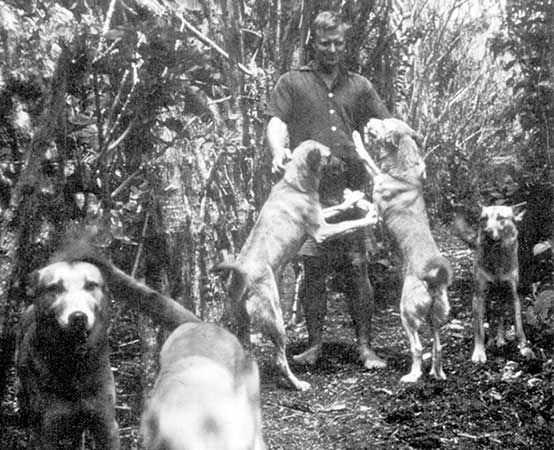
With five tons of equipment ashore and stored under a tarpaulin, the two families could now inspect their new country. In spite of efforts to learn about the island before hand, it surely did not help much—it simply was not like they had expected. For example, for weeks on end, Maja had struggled to keep her cactus plants alive all the way from Rjukan to Santa Cruz, only to discover that there is hardly a place on earth with more cacti than Galápagos!
Alf Kastdalen with the dogs they used for boar hunting and known as the “pig dogs.” Photo taken in 1958 and courtesy of Carl Emil Petersen, Oslo.
The three boys were delighted with their new environment. Here were stretches of white beach, beautiful shells, lovely warm and clear water with fascinating fish, lots of “tame” birds and animals. The black iguanas that crawled along the shore had long claws, scaly skin and a spiny comb down the middle of their back. When they felt threatened, they shook their heads menacingly, and sprayed salty water from their nostrils! The boys thought they had arrived in a fairytale country!
The highlands north of Fortuna where Wold, Moe and Horneman lived, were more like the adults had expected. Perhaps even more fertile. Graffer and Kastdalen each measured out their own 50 acre plots. Kastdalen's slightly higher up. There they cut down enough shrubs and trees to stretch out their tarpaulins, below which they constructed beds protected by mosquito netting, and started a camping style of life that would last for more than one year.
It took several months just to haul all their belongings up from the beach along the 8 to 9 kilometer (5 to 5½ mile) muddy, rocky trail. At the same time they had to clear land, plant the first seeds and build their house. Windows and doors were brought out from Norway; concrete they purchased in Guayaquil. But for the main materials, they had to fell trees in the forest, strip off branches and bark, split and saw the timber into rafters and boards, and plane them by hand.
Before they could harvest their own vegetables, the diet was fairly monotonous. Pork and bananas, bananas and pork. The animals left behind by “Pig-Johansen” grunted everywhere in the bush, and were easy to track down with the help of the dogs. But wild boars were dangerous beasts when they were wounded. Several dogs were injured by their tusks, sharp as razors, and some paid with their lives.
At first it was harder work to provide bananas than meat. Left uncultivated, they grew wild near Santa Rosa, but a trip there with a donkey took several hours each way. But in less than a year they had more than enough from their own crops As long as it was humid, everything grew unbelievably fast, including weeds. Within a week a small patch of cleared red-brown soil could be completely overgrown.
The four in the Kastdalen family chose to celebrate their first Christmas Eve in Galápagos on their own. (Lalla Christoffersen was regarded as a full-fledged member of the family.) It was raining buckets! The festive meal was consumed as merry brooklets of rippling water coursed between the legs of table and chairs. Maja felt sorry for the donkey and the goat which were dripping wet standing outside, so she let them in under the canvas. This situation did not exactly create a typical Christmas sentiment as they knew it from home, but really only the crib and child were lacking…
It was the ability to enjoy even hard work and sacrifice, and quickly replace the pangs of despair with humor and smiles, which was the very strength of the Kastdalens. This made it possible not only to endure but also to thrive with the challenges.
Towards the end of 1936 they finally moved into their new building and named it “Miramar”—ocean view. From the corner sofa by the large living room window they had a view across green treetops down to the black and white coast and the blue Pacific. In clear weather they saw the islands of Santa Fe and Floreana, and on rare occasions also the outline of San Cristóbal.
Miramar was built rather differently from other Galápagos houses of the 1930's. It had a basement made of concrete, half buried into the ground. In this way they had a somewhat cool kitchen, even on the hottest days. The remainder of the house was made of wood, painted white with red trim. A pretty Norwegian-style cottage transplanted to the middle of the jungle. What would become a wide avenue of avocado and casuarina trees [Casuarina, also called Southern Pine, is a long-needled plant native of Australia.] were already shooting up along the path leading down to the Hornemans and the Graffers and beyond to Fortuna.
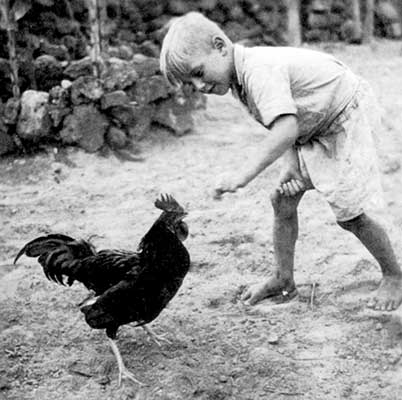
Among the new colonists from Rjukan in 1935 were three small boys who thought they had arrived in a real fairytale country. Here, Erling Graffer teases the rooster belonging to Arthur Worm-Müller. It was named “Don Pedro G.” after a famous pirate. Photo taken in 1936 and courtesy of Rolm Blomberg, Quito.
The Kastdalens were a family of hard workers, content with a life filled with work from sunrise to sunset. They were proud of the visible fruits of their labors: Plots with coffee, bananas, corn and sugarcane; fields abounding in vegetables, sweet potatoes and even Ringerike potatoes. [This is a small reddish potato named after an area near Drammen.] Potatoes were harvested twice and often even three times a year. This vegetable was popular with the other Europeans, and through the sale they generated some income. They could afford to hire help, buy more land, cut, clear and cultivate.
On newly cleared land they would cultivate potatoes for the first few years and as the soil became less productive, convert to pastures for a growing herd of cattle.
Nobody else succeeded with potatoes like the Miramar farmers. Thorvald became affectionately known as “El Rey de Patatas,” or King of Potatoes.
A pest brought about the collapse of the potato harvest in the 1960's, but after 30 years of successful farming they had other crops they could rely on. Cattle and chicken ranching proved to be easier in the long run, but “King of Potatoes” is a respected title in the Galápagos, and Thorvald will retain it as long as he lives.
With dairy cattle, fresh cheese soon followed. The milk was first class even though the half-feral cows had to be dragged in with lasso, and their hind legs tied while being milked. The hand-powered separator functioned just as well at Miramar as in Askim. The results were cream, butter and cheese. In the warm climate of Galápagos cream could not be whipped. Tarts with whipped cream topping had to wait 35 years until a kerosene refrigerator was installed on the farm in 1970.
During the important first few years, these pioneers were lucky to be spared catastrophic drought. Instead they had almost too much rain, mostly in the form of a fine drizzle called garúa. For days and weeks at a time, wet mist can cover the highlands. The Graffer family—like so many others—tired of this humidity, and troubled with rheumatism, built themselves a house at the beach instead.
Possibly because of a well built house, the Kastdalens better tolerated the high humidity. For example, they had glass in all the windows, whereas others often used only mosquito netting.
With the war and the military base at Baltra, prosperity came to the Kastdalens as well as to other Galápagos farmers. The Americans bought practically everything they could produce. Weekly, they loaded pack horses and donkeys and went single file down the trail to Puerto Ayora.
The little village in Academy Bay was regularly getting new inhabitants, mostly Ecuadorian workers from San Cristóbal, Isabela and the continent. Ecuadorian military and civilian authorities followed in their wake. With the increasing need for farmhands arriba, another village grew up in Fortuna next to Gordon Wold's property. It was named Bellavista. [Bellavista was formerly called Fortuna.]
Alf was a giant of a man: 186 cm (6'1") tall, exceeding 100 kg (220 pounds), European shoe size 51 (18 American size). This was a problem because shoes of his size were unavailable in South America. As a result, Alf walked barefoot most of the time.
After the war, relatives in Norway went to the Askim Rubber Factory and had a pair of rubber boots made especially for him. And in the 1970's the weekly family magazine Hjemmet sent him seven pairs of size 18 Norwegian military boots.
Alf's formal schooling was limited to barely three years of elementary school in Rjukan. But there he had to share one teacher with 24 other pupils, whereas at Miramar he had three teachers for himself. After the day's work the boy had his lessons by the light of kerosene lamps.
Soon that was unnecessary. Alf continued on his own and became a self-taught expert, an autodidact. When the Darwin Research Station was established in 1959, he soon revealed himself as the island's foremost botanist. He participated in scientific plant experiments for the University of California at Davis [with Dr. Charles Rick], made his reports and regularly lectured at the research station. There he mostly spoke in English although no one at home mastered this language. But Alf picked it up through books, the Baltra Americans and the English-speaking inhabitants on the island.
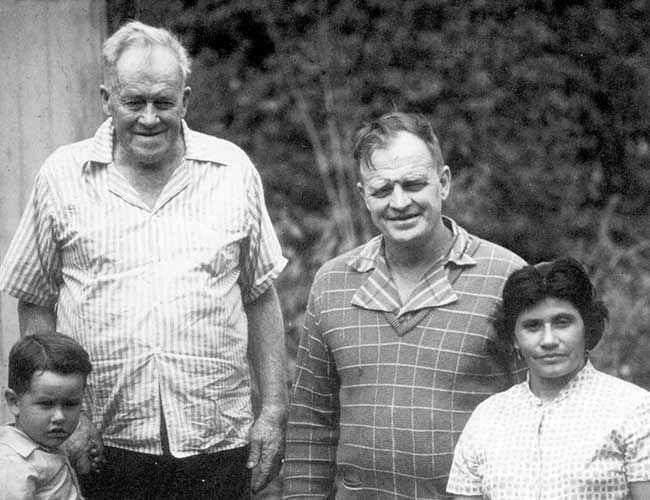
It was not easy for Alf to find a wife on Santa Cruz where mates considered suitable were few and far between. For a short time he was engaged to Friedel Horneman, 15 years younger, but that ended in 1958. Ten years later he found his Corina.
In 1968 Alf Kastdalen married Corina Espin. Thorbaldo was their first child, born in 1970. Here they are together with grandpa Thorvald in 1973. Photo courtesy of Trond Tommelstad, Oslo.
A new class of Ecuadorians had begun to show up on the island. These were mountain farmers from Ambato, a region not far from Quito. Señorita Corina Espin was the first of several siblings who moved to the island and started farming in the Santa Rosa region. Alf proposed, and Corina said yes! Finally there was a wedding in Miramar.
The marriage resulted in the birth of a son, Thorbaldo, in 1970, and a daughter, María, one year later. There was room enough on the extended farm. “Tante Lalla” was also able to enjoy the presence of the children before she, as the first of the old folks, died in 1974.
I visited Miramar for the first time in 1979. I walked up the long avenue of giant trees, kicking wind-fallen avocados, a delicacy in Norway, but mostly pig food on Santa Cruz. Growing wild in the shade of the casuarinas was a thick carpet of “Busy Lizzie” (Impatiens wallerana), a plant that Maja brought from Norway in 1935.
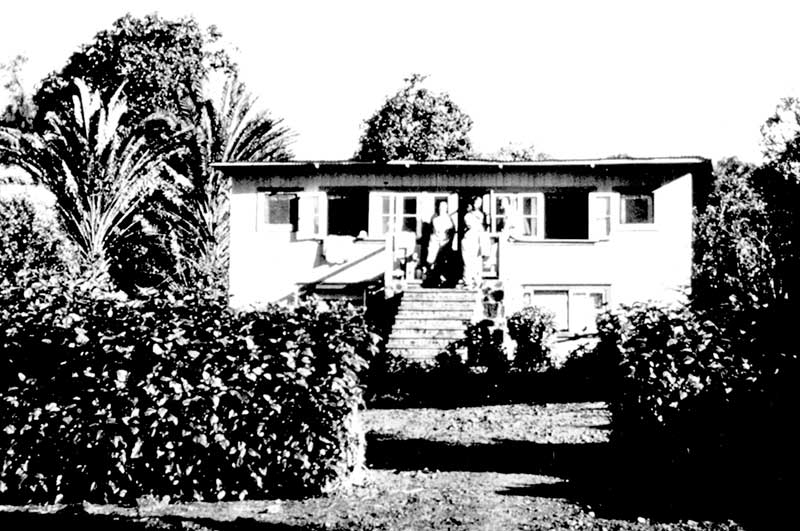
“Miramar” photographed in 1953 by Per Høst.
It seemed strange, sitting in the sheltered Norwegian farmer's living room, with a very un-Norwegian view, listening to Maja's soft Arendal dialect. Thorvald spoke in his harsher east Norway style, spiced with Spanish words. With a brown-eyed child on each knee, Alf talked about the island's future and his own plans. A diesel-powered generator near the beach now provided electricity for several hours each day.
The power line was recently extended to Bellavista, but the last 2-3 kilometers up to Miramar the Kastdalens had to install themselves. They hoped to afford it in a year or two. For 45 years they had looked forward to having electricity on the farm. Hopefully, not so many years would go by before a road was constructed across to the north side of the island. For the time being, it ended in Santa Rosa. When completed there would be only a short ferry trip across to Baltra Island.with its air strip.This would provide better communication with the continent and result in more tourists. Tourism was becoming more and more important for Galápagos, so it was essential to have a road constructed.
“Imagine how much easier it would have been if the road was completed in '72 when I came down with tetanus,” Alf chuckled.
“It was a cut on the finger that started the misery. Strange that I should have reached 47 years of age before such a thing happened—I, who cut and scraped my hands and feet ever since I arrived on the island. Anyway, the tetanus first attacked with painful cramps in the jaw, afterward everywhere in my body. The doctor said the only hope was to get me to Guayaquil. That trip I shall never forget. First all the way down to Puerto Ayora by donkey stretcher, because the road up here was still unfinished. Then by boat around the island to Baltra, and by jeep the last stretch to the airplane. The voyage took two days. At the hospital I was in such spasms that they had to cut my clothes off!”
El Niño
1983 is an El Niño year, one of the severest on record. For days on end it pours down increasingly. It becomes a tragic year for Corina and the Kastdalen family. Three times the church bells at Bellavista will ring for funerals.
The first death has nothing to do with El Niño itself. It is Corina's brother, an experienced rider, who when thrown off his horse is trapped with one foot still in the stirrup. The horse panics and gallops off. An awful way to die, but he is, hopefully, knocked unconscious quickly.
Next it is Maja Kastdalen's turn. The old lady of Miramar has gradually become weaker. The humid heat saps her strength, and mosquitoes and flies are an ever present nuisance. It is almost impossible to keep all insects out of the house. One morning the 86-year-old is unable to get up—and remains in bed until two months later, when she quietly slips away.
Towards the end of July the rains and winds are stronger than ever. In the morning of July 22, Alf is down on the property they bought when the Graffers left. He hears a crackling sound and smells something burning. A stone's throw from the ruins of Graffer's house he finds the source of the problem. Some wet green canes in a tall bamboo thicket are hitting the powerline which spark and crackle with the strongest gusts of wind.
Alf proceeds to Bellavista and gets a man to drive him down to the generator station in Puerto Ayora. He talks with the manager and they decide on how the bamboo should be removed safely.
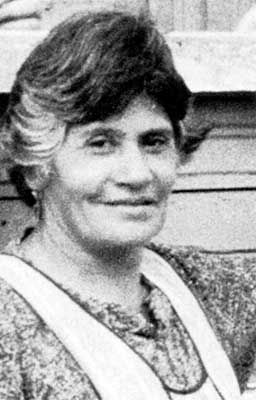
Alf is back early in the afternoon at Miramar. He takes a large machete from the shed, puts on his rubber boots and is off again.
Hours pass, it is still raining heavily, but Alf has not returned. Corina becomes worried. For years Alf has taken tablets to control epilepsy. He has been entirely free of the problem since his marriage but still does not drive a car for fear of a relapse. Could he have forgotten to take his pills?
Corina does not remember exactly what Alf said he would be doing in the rain. Something to do with bamboo? When Thorbaldo returns from school, she sends the 13-year-old out to look for him.
When Thorbaldo finds his father, he has been dead for several hours. He is laying face down on the ground. The big left hand is still clenched around a bamboo pole but badly burned as is the rest of his body on the same side. The doctor said that Alf could not possibly have felt any pain. He had received a jolt of 11,000 volts. But this is poor consolation for those who have lost a son, husband and father.
Corina Kastdalen in 1986. Photo courtesy of Kristian Hosar, Lillehammer.
For the third time in four months Corina has to undergo a velorio, a Catholic 24-hour mourning ceremony when the dead is on display for friends and relatives to bid a final farewell.
The accident seemed so meaningless. Nobody knew exactly what happened. Did Alf expect Señor Rozeso, the manager of the electric power plant, to turn the power off at a particular time? Or did he tell Alf only to cut down the bamboo after the power is turned off at midnight? Did Alf think that rubber boots would provide sufficient insulation?
There is no use brooding—Alf Kastdalen is gone forever.
Epilogue
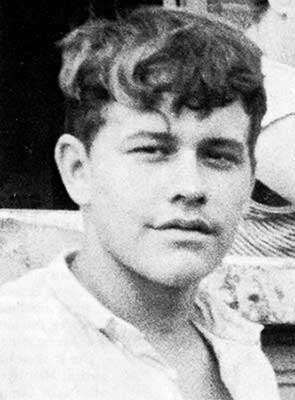
Of about 200 Norwegians—adults and young—who emigrated to Galápagos or were born in the islands, today there is only 15-year old Thorbaldo who bears a Norwegian surname. Photo taken in 1985 courtesy of Kristian Hosar, Lillehammer.
It is 1985. I have written four months ahead of my planned time of arrival, but received no reply; so I do not known if I am expected at Miramar. The bus rattles over a fairly good dirt road from the north side of Santa Cruz across the island. The ride to the boarding house in Academy Bay takes about one hour.
An old man gets off the bus at Bellavista where the Kastdalen family has built a house. He says he will deliver my message. Next morning Thorbaldo meets me in the same green Toyota pick-up that I remember Corina driving six years ago.
Thorbaldo has just turned 15 but is already one head taller than most Ecuadorians. Huge hands, size 11 shoes, brown eyes and darker skin, otherwise the very image of his father. He does not speak much Norwegian but understands it quite well.
I ask about Corina.
She is fine.
And María? And grandfather?
“Si, si—ja, ja—alle OK—arriba.”
Thorbaldo has driven a car since he was nine years old, but in Ecuador it is not legally permitted until the age of 18. So in leaving Puerto Ayora we make a detour away from the police station. Later I would usually do the driving through town. We pass the generator plant and follow the power line to Bellavista.
Here Thorbaldo stops outside a new concrete house and explains that Corina had it built after his father's death. It is easier to live here with a store next door, the school across the square, and a short drive up to Corina's mother and sister's home in Santa Rosa.
He sounds the car horn and a long-legged beauty comes running. The 14-year-old María greets us giggling and jumps into the car before we bump along through the pastures.
The ground is bone dry; many scrawny cattle stand in the shade of sparsely leafed trees. Kastdalens are lucky and can rent trucks which bring brackish water from the beach up to the farm—not everyone can afford that. For the time being they are not forced to slaughter cattle because of the drought.
We stop in front of Miramar. The formerly beautiful rose bushes are also suffering in the drought. The house is in slight disrepair, needing maintenance here and there.
During school vacations they live up on the farm. It was after Alf's accident they had the house built in Bellavista. That is where they live most of the year and where Corina has several friends and less painful memories. But things are slowly improving.
I meet Corina again. Her hair has become grey since we last met. Yes, my letter arrived, muchas gracias, but there was no time to reply—but I should know that I am always welcome.
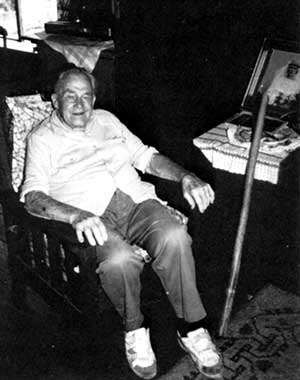
And here is old Thorvald who will soon be 90. Stooped, weak on his legs but with a firm grip on his cane, and his eyes very blue and alive. All the time he smiles and is full of humor and the same good stories about Maja's cacti and the countless wild pigs he has shot. He has a whole drawer full of tusks if anybody should doubt his word. He and Alf must have at least a few thousand pigs on their conscience.
Thorbaldo fetches a Krag-Jørgensen rifle [a Norwegian rifle used as a Norwegian military rifle 1894-1940. Also used by the U. S. army in the late 19th century.] and shows it to me. He is now the hunter but only once a year. It is not easy to track the few feral pigs that remain.
Thorvald Kastdalen was 90 years old on October 13, 1985. Six months earlier, when this photograph was taken at “Miramar,” he said to his grand-children, “I am old now and know that I soon will start my last voyage. I know that you young ones will take over where we gave up, and that task, I believe, you will also manage very well. It is good to think about that.” Photo by the author.
We talk about hard times, easy times, bad and good, but mostly about the latter. Thorvald has managed to accept Alf's premature death, thanks to Corina and the grandchildren. It is a great consolation to know that younger generations will carry on.
Thorvald continually changes into Spanish. “Talk Norwegian, grandfather,” María says laughingly.
“Si, si, yes, yes.” He chuckles and continues in his “Østfold” dialect. “You understand that it is not so easy when one is old and forgetful.”
But Thorvald's memory is crystal clear. Several times more I visit Miramar and learn more about the half century of life as a farmer and immigrant. Thorvald is the last of the Norwegian colonists on this island, just as the Guldberg sisters are on San Cristóbal. Unfortunately, none of the children of former Norwegians on Santa Cruz wished to stay on the island.
We must be allowed to hope that young Thorbaldo Kastdalen will continue the farm and the family name. He will have 2700 mål (675 acres) to look after. This he says he wants to do, and indeed he looks capable of doing so. And for future's sake we want Thorbaldo and María to celebrate primarily on February 12—Galápagos Day.
But we also hope that perhaps they will remember to fly a small Norwegian flag on May 17, Norway's National Day.
Table I
Ship Specifications
An underlined ship name is a link to the text describing that ship.
A camera icon displays that ship's photo and description on this site's “Ships” page.
Motor Schooner Alatga 
The wooden-hulled motor-schooner§ was built in Miami, Florida in 1919 for N. Jeppson of Sweden and named Furustrand. Its gross weight was 460 tons, length was 43.8 meters (143 feet) and it was equipped with two Fairbanks, Morse & Co. semi-diesel engines. The ship was sold to unknown owners in Tvedestrand, Norway and re-named Alatga. In 1926 it was bought by La Colonia de Santa Cruz. After an unsuccessful attempt to sail to Galápagos, it was sold in Panamá in January, 1927. Its new owners and eventual fate are unknown.
§ A motor-schooner is a ship with two or more masts, with the aft mast at least as tall as the foremast(s), with fore-and-aft sails and an auxiliary motor.
Motor Ship Albemarle 
One of the first known ferro-concrete ships to become internationally certified, the ship was built in 1919 at the Greaaker Concrete Shipyard in Moss, Norway for shipowner A. H. Mathiesen, named Concrete, registered at 728 tons with a length of 51.5 meters (169 feet), and equipped with twin 89 horsepower Bolinder diesel engines. It was bought by Randall's Galápagos Expedition in 1926 and re-named Albemarle. It was rebuilt and recertified for passengers partly at Moss Shipyard and partly by expedition members. In March, 1927 it was sold to Harbor authorities in Buenaventure, Colombia. Supposedly wrecked two years later, it was still registered by Lloyds until 1931.
Bark Alexandra 
The steel-hulled bark§ was built in Aberdeen, Scotland in 1874. Its loading capacity was 2,400 tons, and dimensions were 79.3 × 11.3 × 5.3 meters (260 × 37 × 17 feet). It was formerly named Cairnbulg, sailing from Australia in the wool trade. In 1897 it was sold to Finnish Lloyds, Helsinki, and re-named Hellas, again sailing from Australia, but now in the coal and wood trade. In 1902, the ship was sold to Johanson & Co. in Christiania [now, Oslo]. As Alexandra, it continued in the coal trade between Australia and Panamá. It was abandoned on May 8, 1907 and subsequently wrecked near the southwest point of Isla Isabela, Galápagos (described in “Shipwreck on the Bark Alexandra.”)
§ A bark is a three-masted vessel, square-rigged on the first two masts and for-and-aft-rigged on the third.
Motor Schooner Floreana 
The steel-hulled motor-schooner was built in 1895 in Inverkeithing, Scotland, with 387 gross tons. It was first named Vigilant in Kiel, Bremen, Hamburg, Germany while trading in the West Indies and Brazil. It was sold in Sweden, re-named Olga, then re-sold, re-named Start, and an auxiliary engine was installed. It was sold in 1925 to La Colonia de Floreana owner H. A. Christensen and re-named Floreana. Late in 1926 it was sold to a Colombian shipping firm, and subsequently registered in Perú until 1961. Its fate is unknown.
Pilot Cutter Isabela 
The Colin Archer-designed gaff-rigged cutter§ was built about 1896, named Olaf Tryggvason and used as a pilot ship in the Kristiansand area. It was probably 39 feet long, but length is also stated as 36, 41 and 44 feet. It was bought by Axel Seeberg for La Colonia de Floreana in 1925 and re-named Isabela. Before departing Sandefjord on May 24, 1926 with a crew of three, it had a 14 horse-power (diesel?) engine installed. It arrived in Santa Cruz on October 10, 1925. The event was hardly mentioned in Norwegian newspapers and only in 1985, while doing research for this book, was it discovered that this is the first record of a small boat passage from Norway to the Pacific. Isabela was skippered by Paul E. Bruun while trading between Galápagos and the Ecuadorian mainland for just over one year. Its eventual fate is unknown.
§ A gaff-rigged cutter is a small single-masted sailboat with two forestays and a spar or pole (“gaff”) used to extend the upper edge of the main sail.
Motor Ship Robinson Crusoe
This sister-ship of Albemarle was built at the Greaaker Concrete Shipyard, Moss, Norway 1n 1918 and named Fjeldtop. In 1926 it was sold to Sigvald Strømme's Galápagos Expedition and refitted in Porsgrunn. Financial problems prevented this expedition from leaving Norway, and plans were abandoned in December, 1926. The ship was sold, re-named Steingrim, and wrecked off the Swedish coast on August 26, 1928.
Motor Ship Thalassa
The ship was built in Florida as a luxury yacht in 1933, with gross weight of 100 tons, length unknown, and equipped with twin diesel engines. During World War II it was used as a surveillance ship by the U. S. Coast Guard along the east coast. Pacific Fishing, Ltd. (“A/S Stillehavsfangst”) bought Thalassa from Mrs. Tyne Straatveit in U. S. A. in 1948. It was wrecked off Bayona Spain during the night of December 31, 1948/January 1, 1949. Fourteen persons died and only one ten-year-old girl survived.
Motor Schooner Ulva 
The wooden-hulled ship with a Bolinder diesel engine was built at Brastad Shipyard in Vestner, West Norway in 1919. Its gross tonnage was 360 tons, and length was 38.9 meters (125 feet). The first owner was the R. O. Helgesen Co. in Porsgrunn. It was bought by La Colonia de Santa Cruz in 1926, and sold to the Ecuadorian Navy in January, 1927, for use as a cadet training ship, re-named La Patria. One or two years later it was wrecked near La Josefina, Ecuador.
Table II
Shareholders and Crew for Various Expeditions
Each button sorts list by that category. Click again to sort in reverse order.
In Home Town column, “Oslo” followed by a slash and another name indicates the latter is a neighborhood within Oslo.
Table III
Other Norwegian Colonists and Central Figures
Maps
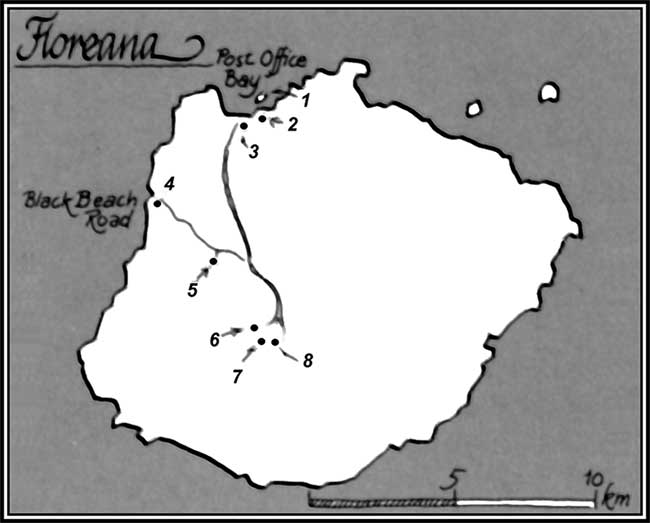
Floreana
- Hvalø (Whale) Island
- Biological Station
- Casa Matriz
- Wittmers' other (later) house
- “Friedo”—Ritter's house
- “Hacienda Paradiso” & “Camp Morten”
- Wittmers' first house and water source
- Pirate caves
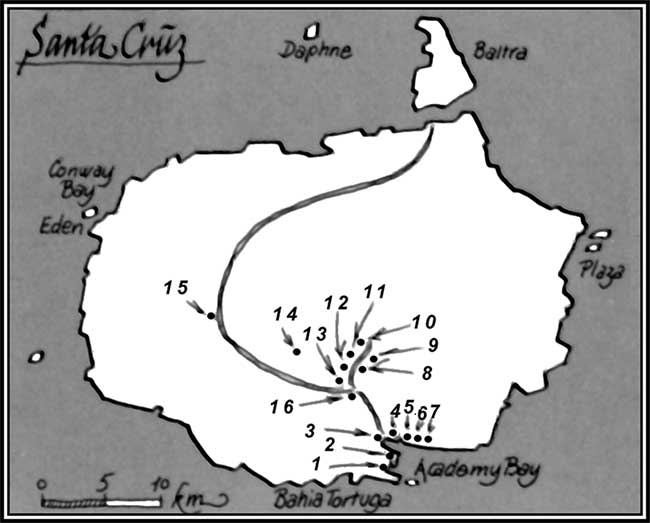
Santa Cruz
- “Arena Blanca”—Stampa's house
- Karl Angermeyer's house
- Ulveneset (Puerto Ayora)
- Graffer's beach house (stone hut)
- Helga Lundh's house
- Rambech's beach house
- Charles Darwin Research Station
- Graffer's house
- “Miramar”—Kastdalen's house
- Rambech's house
- “Villa Villnis” (Wilderness House)—Horneman's house
- Jens Moe's house
- Gordon Wold's house
- “Rancho Grande”—Henriksen's house
- Santa Rosa
- Bellavista
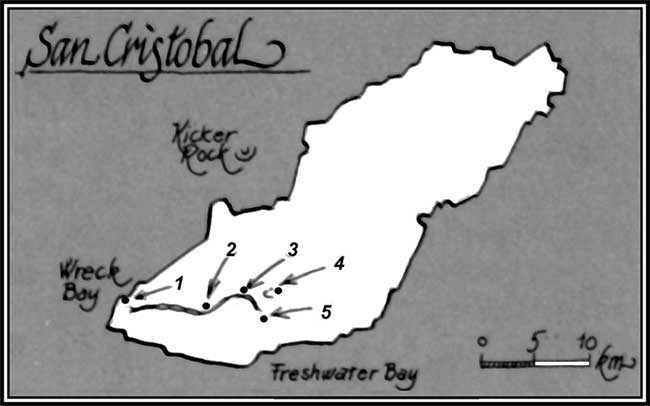
San Cristóbal
- Puerto Baquerizo Moreno
- Progreso
- “Campo Noruego”
- “El Junco”—lake
- “Pampa Mia”— Guldberg sisters' house
